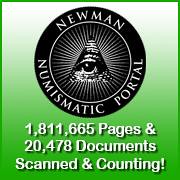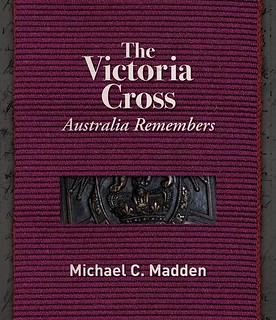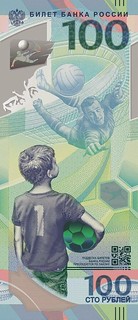
About UsThe Numismatic Bibliomania Society is a non-profit organization devoted to the study and enjoyment of numismatic literature. For more information please see our web site at coinbooks.org SubscriptionsThose wishing to become new E-Sylum subscribers (or wishing to Unsubscribe) can go to the following web page link MembershipThere is a membership application available on the web site Membership Application To join, print the application and return it with your check to the address printed on the application. Print/Digital membership is $40 to addresses in the U.S., and $60 elsewhere. A digital-only membership is available for $25. For those without web access, write to: Terry White, Treasurer AsylumFor Asylum mailing address changes and other membership questions, contact Terry at this email address: terrywhite5475@yahoo.com SubmissionsTo submit items for publication in The E-Sylum, write to the Editor at this address: whomren@gmail.com
BUY THE BOOK BEFORE THE COIN |
- WAYNE'S WORDS: THE E-SYLUM JULY 11, 2018
- NBS EVENTS PLANNED FOR 2018 PHILADELPHIA ANA
- KOLBE & FANNING ADAMS SALE CLOSES JULY 14, 2018
- NEW BOOKS ON INDIAN COINAGE
- NEW BOOK: THE VICTORIA CROSS
- NEW BOOK: THE PAPER MONEY OF ARGENTINA
- OMNI JOURNAL JUNE 2018 ISSUED
- WILLARD ROYAL MUMFORD (1933-2018)
- IBNS JOURNAL ON NEWMAN PORTAL
- THE ALEXANDRE VATTEMARE COLLECTION
- NEWMAN'S DECLARATION OF INDEPENDENCE BROADSIDE
- BREEN AND TAXAY AUTHENTICATION CERTIFICATES
- NOTES FROM E-SYLUM READERS: JULY 8, 2018
- QUERY: EAST INDIA COMPANY COIN FIELD PATTERN
- THE WASHINGTON HALL OF FAME MEDAL
- CENTRAL STATES SUSPENDS AUTHOR GRANT PROGRAM
- VOCABULARY TERMS: SO-CALLED DOLLAR, SOUVENIR MEDALS
- OTHO JACOB BIERLY (1871-1957)
- QUERY: A ZERBE-HEEREN CONNECTION?
- INDIANA STATE MUSEUM HEEREN BROS COLUMBIA SHIELD
- VIDEO: EAC REMEMBERS R. TETTENHORST
- SUMMER SEMINAR BOOK SALE FINDS
- WHICH NAPOLEONIC MEDALS DID PEALE SEE?
- PAINTING RECREATES JEFFERSON'S COIN TRANSACTION
- TAMS MEETING AND BANQUET IN PHILADELPHIA
- NUMISMATIC NUGGETS: JULY 8, 2018
- ROMAN COINS FOUND AT VULCI
- HENRY VIII ANGEL SOUGHT IN MURDER INVESTIGATION
- 1982 NETHERLANDS-AMERICAN 50 GULDEN
- IRAN'S SULTAN OF COINS
- BLACK HOLE SPINNERS
- RARE HBC PROMISSORY NOTE AT REGINA COIN SHOW
- DID RUSSIA WORLD CUP BANKNOTE PREDICT WIN?
- IN OTHER NEWS: JULY 8, 2018
- VAULT RELEASE – RARE LINCOLN PENNIES!!!
- FEATURED WEB SITE: SHORT SNORTER PROJECT
Click here to access the complete archive
To comment or submit articles, reply to whomren@gmail.com
Content presented in The E-Sylum is not necessarily researched or independently fact-checked, and views expressed do not necessarily represent those of the Numismatic Bibliomania Society.
WAYNE'S WORDS: THE E-SYLUM JULY 11, 2018
 This week we open with NBS events at the ANA Philadelphia show, a final reminder of the Kolbe & Fanning sale of John W. Adams library selections, five new books and one periodical, and the loss of a hobby stalwart.
This week we open with NBS events at the ANA Philadelphia show, a final reminder of the Kolbe & Fanning sale of John W. Adams library selections, five new books and one periodical, and the loss of a hobby stalwart.
Other topics this week include the International Bank Note Society (IBNS), Breen and Taxay authentication certificates, Hall of Fame medals, dealer O. J. Bierly, the Columbia Shield, and Short Snorters.
To learn more about the Victoria Cross, the OMNI Journal, Will Mumford, the Alexandre Vattemare Collection, Chinese Sycee, the Central States Author Grants Program, The Coin Press, and Black Hole spinners, read on. Have a great week, everyone!
Wayne Homren
Editor, The E-Sylum
NBS EVENTS PLANNED FOR 2018 PHILADELPHIA ANA
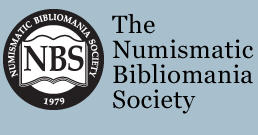 With the ANA World's Fair of Money in Philadelphia just weeks away I would like to invite the E-Sylum readership to join the Numismatic Bibliomania Society's annual events. We are delighted to have numismatic scholar, researcher and author Roger Burdette, speaking at our Symposium on Thursday, August 16 at 1:00 in room 120 C on numismatic research at the National Archives. This will be a fascinating look at the challenges and discoveries through Roger's extensive experiences.
With the ANA World's Fair of Money in Philadelphia just weeks away I would like to invite the E-Sylum readership to join the Numismatic Bibliomania Society's annual events. We are delighted to have numismatic scholar, researcher and author Roger Burdette, speaking at our Symposium on Thursday, August 16 at 1:00 in room 120 C on numismatic research at the National Archives. This will be a fascinating look at the challenges and discoveries through Roger's extensive experiences.
Our General Meeting held Friday, August 17 at 11:30 in room 117 will include the announcement of The Asylum author award winners. We are also looking forward to a timely presentation by numismatic literature dealer, David Fanning, discussing the current state of the numismatic literature market. This will be a great opportunity to hear David's insightful thoughts regarding today's numismatic literature trends. Our all-important benefit action will conclude the meeting and, as always, will include several special items.
This year we have renewed our tradition of hosting an NBS club table. The table will be located near literature dealers Charles Davis and Kolbe & Fanning. We hope everyone will have an opportunity to stop by the table to visit and receive a complimentary NBS bookmark. This will be a great chance to connect with fellow literature enthusiasts and share your thoughts for the betterment of the NBS.
KOLBE & FANNING ADAMS SALE CLOSES JULY 14, 2018
THIS SATURDAY, JULY 14
Live Online Auction Begins at Noon Eastern Time
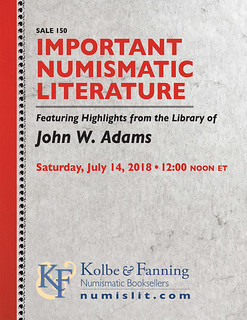 Selected highlights of the magnificent John W. Adams numismatic library will be sold this Saturday, July 14, beginning at 12:00 noon Eastern Daylight Time by Kolbe & Fanning Numismatic Booksellers. The online catalogue can be accessed at
bid.numislit.com.
Selected highlights of the magnificent John W. Adams numismatic library will be sold this Saturday, July 14, beginning at 12:00 noon Eastern Daylight Time by Kolbe & Fanning Numismatic Booksellers. The online catalogue can be accessed at
bid.numislit.com.
Bids may be placed via post, email, fax or phone, as well as online. Bids placed via post, email, fax or phone must be received by Friday, July 13, the day before the sale, in order for them to be processed. Kolbe & Fanning uses Auction Mobility as our third-party online bidding platform. Auction Mobility is an app-based platform allowing users the ability to participate in the sale through phones, tablets and computers. To register for the sale, bidders must go to bid.numislit.com and sign up. Once you have set up an account, you may browse lots, place advance bids, or participate in the live sale online. Those wishing to participate on their devices can download the Kolbe & Fanning app through the Apple or Google Play Store.
Advance absentee bids may also be placed online at bid.numislit.com; live internet bidding will be available during the sale itself through the same platform. Bidders placing absentee bids will be able to tell immediately whether or not they have the current high bid. Bidders will also receive email notifications when they are outbid before the sale (users of the app may receive push notifications as well).
The Adams Library has been generating considerable excitement and advance bidding, and we are looking forward to your participation in what promises to be a memorable sale.
Kolbe & Fanning Numismatic Booksellers LLC is a licensed and bonded auction firm in the State of Ohio. For more information, please see the Kolbe & Fanning website at numislit.com or email David Fanning at df@numislit.com. To register for the sale, go to bid.numislit.com. We look forward to your participation.
To read the earlier E-Sylum articles, see:
KOLBE & FANNING ANNOUNCES JULY 14, 2018 SALE
(http://www.coinbooks.org/v21/esylum_v21n20a04.html)
KOLBE & FANNING OFFER ADAMS CHAPMAN CATALOGUES
(http://www.coinbooks.org/v21/esylum_v21n21a04.html)
KOLBE & FANNING OFFER ADAMS RAYMOND CATALOGUES
(http://www.coinbooks.org/v21/esylum_v21n22a08.html)
KOLBE & FANNING OFFER ADAMS ELDER CATALOGUES
(http://www.coinbooks.org/v21/esylum_v21n23a02.html)
KOLBE & FANNING OFFER ADAMS FROSSARD CATALOGUES
(http://www.coinbooks.org/v21/esylum_v21n24a02.html)
KOLBE & FANNING OFFER ADAMS LYMAN LOW CATALOGUES
(http://www.coinbooks.org/v21/esylum_v21n25a02.html)
KOLBE & FANNING ADAMS SALE CLOSES JULY 14, 2018
(http://www.coinbooks.org/v21/esylum_v21n26a02.html)
FIRST ARTICLE ON AMERICAN NUMISMATICS, REVISED
(http://www.coinbooks.org/v21/esylum_v21n26a25.html)
VATTEMARE'S 1861 CATALOGUE
(http://www.coinbooks.org/v21/esylum_v21n26a26.html)
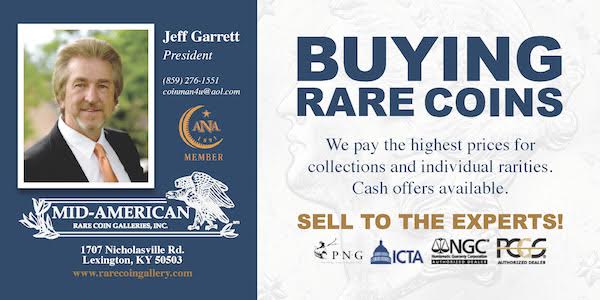
NEW BOOKS ON INDIAN COINAGE
The Nawabs and Kings of Awadh and their Coinage
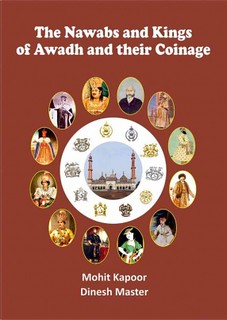 The Nawabs and Kings of Awadh and their Coinage
The Nawabs and Kings of Awadh and their Coinage
Genres: Art and Architecture Numismatics
Authors (s): Mohit Kapoor (Author) , Dinesh Master (Author)
Format: Hardcover
ISBN-10: 9352684044
ISBN-13: 9789352684045
Pages: 79p., Plates; 29cm.
Pub. date: 03.07.2018, 1st. ed.
Publisher: Mohit Kapoor & Dinesh Master
Language (s): English
Bagchee ID: BB3340
List price: US $ 150,00
Bagchee price: US $ 135,00
You save: (10.00%)
Member price: US $ 121,50
A book covering a brief history of the land of Awadh, its Nawabs and Kings and also cataloguing the coins issued by the Nawabs and Kings of Awadh from the various places governed by them. The book also cover the medallions and also a few seals used by the Nawabs and Kings of Awadh.
For more information, or to order, see:
The Nawabs and Kings of Awadh and their Coinage
(http://www.bagchee.com/books/BB3340/the-nawabs-and-kings-of-awadh-and-their-coinage)
Post-Kidarite Coins Of The Gangetic Plains And Punjab Foothills
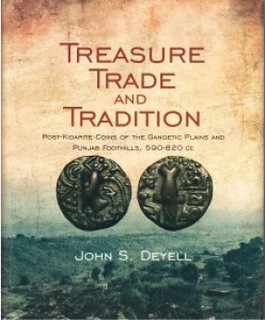 Treasure Trade And Tradition Post-Kidarite Coins Of The Gangetic Plains And Punjab Foothills, 590-820 CE
Treasure Trade And Tradition Post-Kidarite Coins Of The Gangetic Plains And Punjab Foothills, 590-820 CE
Authors (s): John S. Deyell (Author)
Format: Hardcover
ISBN-13: 9789350981337
Pages: 228p.,
Pub. date: 27.07.2017, 1st. ed.
Publisher: Manohar Publishers & Distributors
Language (s): English
For more information, or to order, see:
Treasure Trade And Tradition Post-Kidarite Coins Of The Gangetic Plains And Punjab Foothills, 590-820 CE
(http://www.bagchee.com/books/BB109119/treasure-trade-and-tradition-post-kidarite-coins-of-the-gangetic-plains-and-punjab-foothills-590-820-ce)
Coins of Shah Jahan
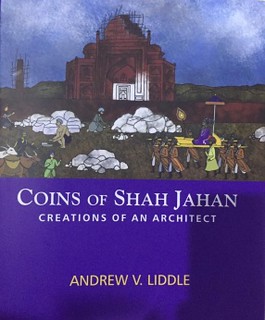 An Officer of the Indian Police Service. Andrew Verity Liddle retired as the Director General of The Central Reserve Police Force in September 1996. He has been collecting and studying Mughal coins for several decades, with special focus on the coins of the Grand Mughals. Both his earlier books (Coins of Jahangir & Coinage of Akbar) have been received well by the Mughal numismatic fraternity all over the world and continue to be quoted extensively in auction catalogues.
An Officer of the Indian Police Service. Andrew Verity Liddle retired as the Director General of The Central Reserve Police Force in September 1996. He has been collecting and studying Mughal coins for several decades, with special focus on the coins of the Grand Mughals. Both his earlier books (Coins of Jahangir & Coinage of Akbar) have been received well by the Mughal numismatic fraternity all over the world and continue to be quoted extensively in auction catalogues.
For more information, or to order, see:
Coins of Shah Jahan: Creations of an Architect
(http://www.bagchee.com/books/BB108188/coins-of-shah-jahan-creations-of-an-architect)
To read the earlier E-Sylum article, see:
BETTER PRICES FOR NUMISMATIC BOOKS FROM INDIA
(http://www.coinbooks.org/esylum_v17n24a05.html)
NEW BOOK: THE VICTORIA CROSS
A Victorian man's journey to thank the organisation that helped his father from the effects of war, has led him to write the first book to document the 100 recipients of Australia's highest military honour – The Victoria Cross.
Michael Madden spent four and a half years of his life dedicated to writing The Victoria Cross: Australia Remembers – the first ever collection of the stories of every soldier who has received the most prestigious bravery award in the country.
Little did he know how tough it would be.
"It's something that I wouldn't do again, no way," Mr Madden said.
A medal mounter and real estate photographer by trade, Mr Madden knew it would be tricky tracking down the stories of the 100 men who were awarded the Victoria Cross, and said it was like trying to find a needle in a haystack.
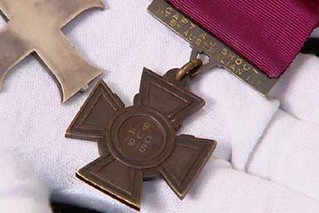 "Finding the families was the hardest part because there's no register that shows where these men are, so tracking down the families and getting the stories of these men was very hard," he said.
"Finding the families was the hardest part because there's no register that shows where these men are, so tracking down the families and getting the stories of these men was very hard," he said.
What started as a side project, quickly took over Michael's life, forcing him to close his two businesses, and leave his family for long periods of time to meet with relatives of the Victoria Cross recipients.
Researching the book involved Mr Madden travelling to 17 countries, where he photographed all 100 Victoria Cross medals, interviewed the families of the 96 who have died and the four ex-servicemen who are still alive.
Mr Madden hoped the book would help young people get involved in military history.
All profits of the book will go directly to the Totally and Permanently Incapacitated Ex-Servicemen and Women.

Author Michael Madden
To read the complete article, see:
Australia's 100 Victoria Cross medal recipients now documented in first book of its kind
(http://www.abc.net.au/news/2018-07-03/victoria-cross-book-documents-australias-bravest/9932050)
NEW BOOK: THE PAPER MONEY OF ARGENTINA
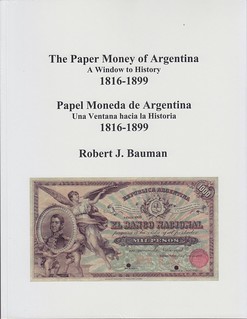 Although published in Argentina, being this a bilingual book by a native of the United States, I will review it both in English, which is the author's language, and Spanish, which is the tongue of the subject chosen. As there is widespread interest among currency collectors worldwide in Argentine paper money, and of course also in Argentina, this billingual review will be beneficial to them all.
Although published in Argentina, being this a bilingual book by a native of the United States, I will review it both in English, which is the author's language, and Spanish, which is the tongue of the subject chosen. As there is widespread interest among currency collectors worldwide in Argentine paper money, and of course also in Argentina, this billingual review will be beneficial to them all.
Argentine paper money has been the subject of several important catalogues in the last two decades: the outstanding work by Roberto Bottero (Billetes de la Replica Argentina, Buenos Aires, 2001), a useful compendium catalogue by Mariano Cohen, and most recently, an entirely new catalogue by Eduardo Colantonio ... However, all these works were devoted to modern (1890 or later) issues; collectors of 19th century Argentine paper money were relegated to use the general volumes of World Paper Money (Krause Publications) and refer the Argentina section of those catalogues, which lack both details and historical notices (notably less than the seriously defective companion series dealing with world coins, also by Krause which in addition, especially in recent editions, include more errors than information).
In this context, Bauman's new book is a very welcome addition to any numismatic library and of course, a must for every currency collector. The issues of Argentine paper money since the Declaration of Independence from Spain in 1816, until the introduction of the Currency Board (Caja de Conversion), and including the provincial, emergency, private, and national issues, are listed, described and illustrated with the outmost detail, including abundant historical notices. The images, all in full color and reproduced in remarkable quality, frequently reproduce every relevant variety. Prices are in all cases given for 3 grades of conservation, from good to uncirculated, according to the average preservation of each of the relevant series.
To read the eBay listing, see:
THE PAPER MONEY OF ARGENTINA 1816-1899 by ROBERT J. BAUMAN. 2016 323 pp
(https://www.ebay.com/itm/THE-PAPER-MONEY-OF-ARGENTINA-1816-1899-by-ROBERT-J-BAUMAN-2016-323-pp-/152701329347)

OMNI JOURNAL JUNE 2018 ISSUED
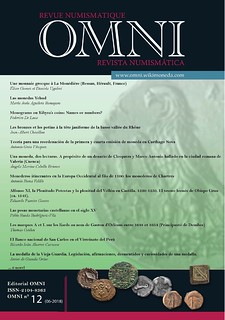 We are delighted to disseminate our newspaper as a free download. This is a key element to ensure the wide dissemination of studies, in particular for numismatics. We remind the OMNI journal is still freely downloadable in PDF format thanks to advertising support.
We are delighted to disseminate our newspaper as a free download. This is a key element to ensure the wide dissemination of studies, in particular for numismatics. We remind the OMNI journal is still freely downloadable in PDF format thanks to advertising support.
Since 2011, OMNI is hosted on our servers (www.omni.wikimoneda.com) which allows us to count the number of downloads: more than 77,000 since 2011! To these numbers we must add the quantity of downloads for each article indexed on several international research platforms, such as ERIHPLUS, REDIB, DIALNET, or LATINDEX. Let us give an example: In the last issue (OMNI no. 11) the article “Las marcas de las monedas leonesas y castellanas del s. XII en el proceso de fabricación de moneda”, written by Antonio Roma Valdés, was downloaded more than 2,400 times from our servers.
Once again, encouraged by such results, we are happy to publish the 12th issue of OMNI. This volume consists of 15 articles (For information: 85% of the articles received were accepted by the academic Scientific Committee). In OMNI, archeologists, numismatists, engineers and historians are welcome to join forces in order to ensure the cohesion of these disciplines.
As always, we will endeavor to do the best to disseminate relevant numismatic works. Thank you very much for your interest in OMNI
Federico De Luca
Monograms on Kibyra's coins: Names or numbers?
David Martnez Chico
New decanummium of Justin II from Carthage (c. 566-572 AD)
Ricardo Iván Alvarez Carrasco
El Banco nacional de San Carlos en el Virreinato del Peru
Javier de Granda Orive
La medalla de la Vieja Guardia. Legislación, afirmaciones, desmentidos y curiosidades de una medalla
Anonymous
The Paper Money of Argentina: A Window to History, 1816-1899 Papel Moneda de la Argentina: Una Ventana hacia la Historia, 1816-1899
Anonymous
Billetes Argentinos, 1884-1916
To read the complete article, see:
http://www.wikimoneda.com/omni/
WILLARD ROYAL MUMFORD (1933-2018)
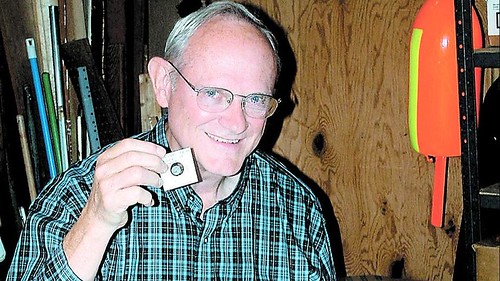
Willard R. Mumford, in this file photo from 2003, holds up a historic coin made by Annapolis silversmith John Chalmers. (Wendi Winters / Capital Gazette)
Local historians don't come more passionate than Willard R. Mumford, a retired Air Force officer who taught engineering at Anne Arundel Community College – just as his father had taught electrical engineering at the Naval Academy. He died earlier this month at age 84.
One of those people who want to know everything about a subject that has caught their interest, Mumford worked on archaeological digs, accumulated thousands of documents on Annapolis during the Civil War, collected hundreds of historic coins – some of them dug up in Annapolis – and wrote what is probably the definitive book on a largely forgotten facet of this region's heritage: "Strawberries, Peas & Beans: Truck Farming in Anne Arundel County."
Those who pick up that book will find out about the days when much of northern Anne Arundel was given over to growing produce; at one point Anne Arundel had more acreage planted in strawberries than any other spot in the U.S.
Mumford came to the subject naturally: His first job was working in tobacco fields on land off Defense Highway now covered by shopping centers "I did not want to see that history lost," he said.
Thanks to him, it won't be. Mumford always had a story about history and was always trying to teach. His enthusiasm was contagious – and we hope a lot of people caught it. How will we meet the challenges of the future without a solid appreciation of our past?
To read the complete article, see:
Our say: Mumford one of those who illuminated the past
(http://www.capitalgazette.com/opinion/ac-ce-our-say-20180615-story.html)
Here's an excerpt from Will's online obituary. -Editor
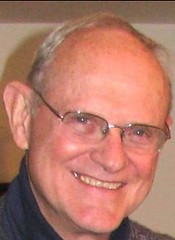 Will was born in McMinnville, Oregon on August 1, 1933, and moved to Annapolis, Maryland in 1944 when his father was assigned to the Naval Academy as a professor of Electrical Engineering. Will graduated from Germantown Elementary School and Annapolis High School where he served as president of the class of 1951. He was active in the Boy Scouts and obtained the rank of Eagle Scout. After graduating from the University of Maryland with a degree in Education, he was commissioned a Second Lieutenant in the United
States Air Force. He ended his Air Force career as Deputy Director of the Electromagnetic Compatibility Analysis Center in Annapolis.
Will was born in McMinnville, Oregon on August 1, 1933, and moved to Annapolis, Maryland in 1944 when his father was assigned to the Naval Academy as a professor of Electrical Engineering. Will graduated from Germantown Elementary School and Annapolis High School where he served as president of the class of 1951. He was active in the Boy Scouts and obtained the rank of Eagle Scout. After graduating from the University of Maryland with a degree in Education, he was commissioned a Second Lieutenant in the United
States Air Force. He ended his Air Force career as Deputy Director of the Electromagnetic Compatibility Analysis Center in Annapolis.
Will served as president of the Ann Arrundell County Historical Society from 1988 to 1994. During this time the society developed the concept of making the property of the Benson-Hammond House an Interpretive Truck Farm, acquired the Kiethe Library, and initiated the annual Strawberry Festival. He was District Chairman for the Capitol District Boy Scouts of America; a member and director of the Annapolis Rotary Club; president of the Maryland State Numismatic Association, the Colonial Coin Club, the Utah Numismatic Society, and the Chesapeake Chapter of the Armed Forces Communications and Electronics Association.
He served for over 20 years as the editor of the Civil War Token Society journal and from 1988 to 2017 as the editor of the Maryland Tokens and Medals Society Journal. Will enjoyed making presentations to community groups and made over 400 presentations on various subjects, mostly on Maryland history and numismatics. For many years, Will was an active volunteer in local archaeological programs.
In 2003, Will found a rare Chalmers' three pence at an archeological dig at 10 Cornhill Street; believed to be the workshop of the Annapolis colonial silversmith, John Chalmers. In his "retirement" Will authored "Strawberries, Peas and Beans; Truck Farming in Anne Arundel County," "Barter, Bits, Bills and Tobacco; The Story of Money in Early Maryland" and the soon to be published "The First 100 Years: The First Presbyterian Church of Annapolis, Maryland." Will served as the Chairman of the Anne Arundel County Trust of Preservation from 1999 to 2017 and coordinated the History Lecture series at St. John's College. He also taught a course of the History of Anne Arundel County at Annapolis and South County Senior Centers through Anne Arundel Community College.
To read the complete article, see:
Willard Royal Mumford (1933 - 2018)
(https://www.legacy.com/obituaries/CapitalGazette/obituary.aspx?pid=189254618)
IBNS JOURNAL ON NEWMAN PORTAL
 Founded in 1961, the International Bank Note Society (IBNS) operates as a non-profit educational organization with the purpose to promote, stimulate, and advance the study and knowledge of worldwide banknotes and paper currencies. Currently the IBNS has over 2,000 members in more than 90 countries.
Founded in 1961, the International Bank Note Society (IBNS) operates as a non-profit educational organization with the purpose to promote, stimulate, and advance the study and knowledge of worldwide banknotes and paper currencies. Currently the IBNS has over 2,000 members in more than 90 countries.
The IBNS board has recently approved sharing the IBNS Journal, through 2016 (issue no. 55.2), on the Newman Portal. The IBNS Journal is an indispensable resource covering all aspects of world paper money, including issues past and present. The Newman Portal acknowledges Roger Urce (IBNS General Secretary), Robin Hill (IBNS Webmaster), and Pamela West (IBNS Director) for their assistance with the project.
Link to International Bank Note Society home page:
https://www.theibns.org/
Link to International Bank Note Society Journals on Newman Portal:
https://nnp.wustl.edu/library/publisherdetail/527392

THE ALEXANDRE VATTEMARE COLLECTION
Bob Kebler writes:
Thank you for the tremendous service you provide each and every week with The E-Sylum. I have two items that may be of interest, one pertaining to the Vattamare Catalog that you profiled last week, the other relating to a Declaration of Independence broadside and Eric Newman.
Two months ago (in the 4/22 and 4/29 issues) you noted a couple of submissions about the passing of Bernard Edison (R. Tettenhorst or Tett). During 2014 - 2016 I was privileged and honored to be able to collect and organize the R. Tettenhorst Archival Collection, which was donated to the Newman Numismatic Portal in 2017 and was scanned into the portal in 2018.
In these records is a fascinating group of material in which Tett, who was fluent in French, visited the Bibliotheque Nationale in Paris in 1995 to see the coins that were in the Vattamare exhibit. I include a summary of the items from my listing of Tett's material.
Tett learned of an exhibition of half cents, large cents, and other US coins at the Bibliotheque Nationale in 1861. The Alexandre Vattemare Collection was described in the exhibition catalog, and it is one of the earliest half cent collections described in the literature.
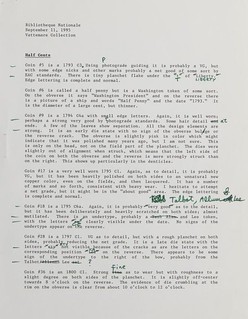
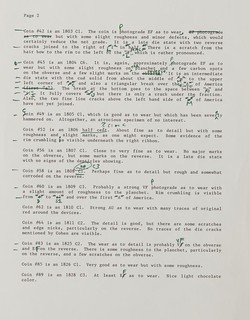
The material includes:
As a follow-up to this, I asked Tett why he never wrote an article about this for Penny-Wise, as it is a remarkable and fascinating story. He told me that we wanted to, but the Director of the Library did not want the government to know about the coins because he was afraid they would take them for taxation purposes.
Interested readers can access these records at https://nnp.wustl.edu/library/archivedetail/523464, the specific collection is filed under the year 1995.
To read the earlier E-Sylum articles, see:
BERNARD ALAN EDISON (1928-2018)
(http://www.coinbooks.org/v21/esylum_v21n16a07.html)
ROSE M. TETTENHORST (1936-1989)
(http://www.coinbooks.org/v21/esylum_v21n16a26.html)
R. TETTENHORST
(http://www.coinbooks.org/v21/esylum_v21n17a12.html)
VATTEMARE'S 1861 CATALOGUE
(http://www.coinbooks.org/v21/esylum_v21n26a26.html)
NEWMAN'S DECLARATION OF INDEPENDENCE BROADSIDE
Bob Kebler writes:
An article in the St. Louis Post-Dispatch is about the Declaration of Independence broadside owned by Eric Newman, which hung in his house for many years, and is now on display at Washington University.
 The official handwritten Declaration of Independence wasn't even signed until Aug. 2, 1776. That revered, calligraphic version is in the National Archives, much faded.
The official handwritten Declaration of Independence wasn't even signed until Aug. 2, 1776. That revered, calligraphic version is in the National Archives, much faded.
But a copy at Washington University in St. Louis actually was made earlier than the official document. The university was given in 2015 a rare, printed broadside and has built a permanent display of its copy.
Only seven Southwick broadsides are known to survive. Washington University's copy is one.
Brand says that the Southwick broadside was actually the first signed Declaration, with Rhode Island's secretary of state, Henry Ward, signing it to attest to its legitimacy.
The university's copy was owned by Eric and Evelyn Newman for six decades, hanging on the wall of their Clayton home.
"He was very proud of it," says John Hoover, who saw the Southwick broadside in the Newmans' home. "It's a very princely gift to Washington University."
The Newmans were active philanthropists in St. Louis, with Evelyn Newman involved in starting the Greater St. Louis Book Fair and the ScholarShop. She died in 2015; Eric Newman, a lawyer and coin authority (his collection eventually brought $72 million at auctions), died in 2017.
The Newmans donated not only the historic Declaration of Independence to Washington University, but gave some $10 million to help refurbish its library.
To read the complete article, see:
Made in 1776: Rare copy of the Declaration of Independence goes on view at Washington U.
(https://www.stltoday.com/entertainment/books-and-literature/made-in-rare-copy-of-the-declaration-of-independence-goes/article_7e07b5dd-3129-5ebc-a0da-47169f0fd0ae.html)
To view the complete video, see:
"Hot news" – The Southwick Broadside
(https://www.youtube.com/watch?v=fxHlfBo_UBI)
To listen to a St. Louis Public Radio interview baout it, see:
Rare copy of Declaration of Independence on display at Wash U
(http://news.stlpublicradio.org/post/rare-copy-declaration-independence-display-wash-u#stream/0)
BREEN AND TAXAY AUTHENTICATION CERTIFICATES
Breen-Taxay First Coinvestors Certificate
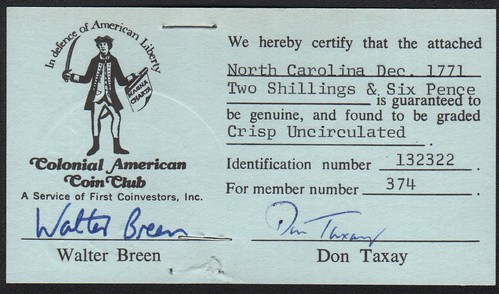
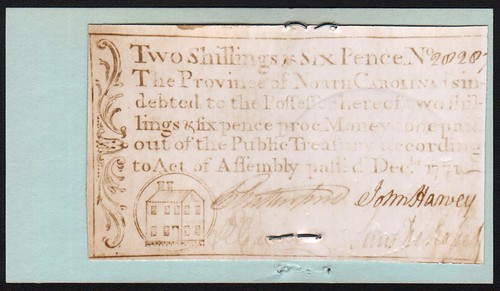
Dave Lange writes:
Regarding the Breen authentication letters posted at the Newman Numismatic Portal I have something similar that may be of interest. It's a small (2.5" x 4.5") certificate that was signed by both Walter Breen and Don Taxay authenticating and grading a 1771 North Carolina note. They were then working for Stanley Apfelbaum's First Coinvestors, Inc.
The certificate was issued to a member of the company's Colonial American Coin Club, and it likely dates to the early-mid 1970s. A photocopy of the note is stapled to the back, as issued, and the certificate itself was formerly stapled to a holder containing the note. I traded the latter a few years ago to a dealer for a Whitman coin folder printing plate that he wouldn't sell for cash. Instead, he said to offer him something historic and cool, so I sacrificed the note, which was indeed quite nice. I never mentioned the certificate, which was of nearly equal interest to me for its association with two controversial figures in numismatics.
Taxay and Taxay Associates Certificates
Tom Caldwell of Northeast Numismatics writes:
In a collection we purchased this week were these two coins that came with accompanying certificates. Much like the more occasionally encountered ANACS certificates of the era these were the first we had seen from Taxay. We know there are collectors out there for different grading holders from the past 40 years of so but not sure if this one has been acknowledged.
One is signed by Mike Berton as an "associate" who around that time did business with Taxay as did ourselves. Don & his wife used to visit our office every few months during this time period when we were in Acton, MA.
Mike is the son in-law of Ed Leventhal, the founder of JJ Teaparty formerly of Bromfield St in Boston. Mike is still involved in numismatics & working with the the new owners of Teaparty. The time period between the two Certificates is about the time Taxay disappeared, so it appears that Berton in some sort of way continued working with Taxay as an associate.
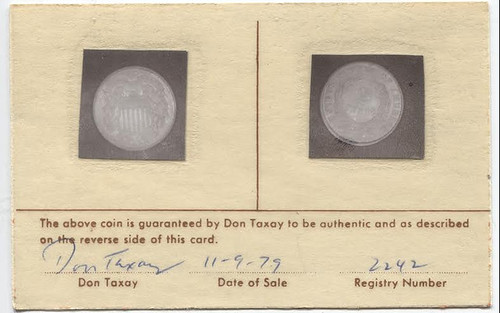
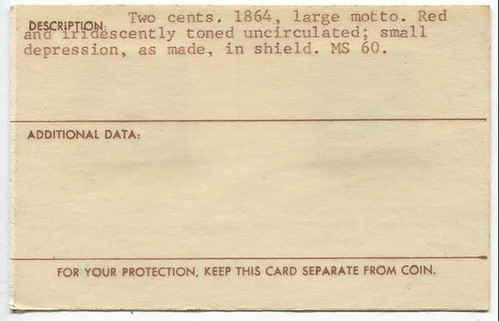
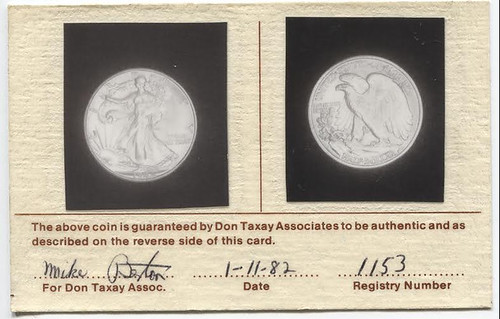
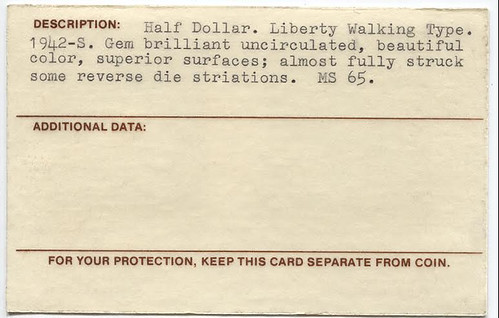
Tom adds:
The bigger mystery is perhaps what happened to Don Taxay? At the height of his career after authoring books in the 1960's & 70's Don seemingly disappeared. A quick Google search reveals that it is believed that Don around this time period converted his wealth & possibly from the influence of Walter Breen moved to India never to be seen or heard from again. Perhaps some other readers will have some new information in regards to Don today?
To read the earlier E-Sylum article, see:
BREEN AUTHENTICATION CERTIFICATES ON NEWMAN PORTAL
(http://www.coinbooks.org/v21/esylum_v21n26a08.html)
NOTES FROM E-SYLUM READERS: JULY 8, 2018
The Treasures of Paris Coins

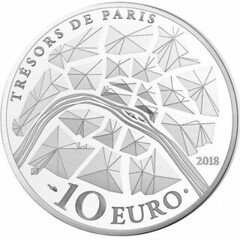
Francois R. Velde writes:
The reverse represents the city of Paris, crossed by the Seine river and divided into 20 arrondissements or wards (6 on the Left Bank or south of the river, 14 on the Right Bank), represented as little pyramids. The arrondissements are numbered in a clockwise spiral starting in the center.
The series is called "Treasures of Paris" (broadly construed, apparently, since Versailles is outside city limits) and features monuments that feature gilding. The gate of Versailles, which had been dismantled at the Revolution, was rebuilt a few years ago as it stood at the time of Louis XIV.
Other monuments in the series include the Palais Garnier (the opera house from 1875 to 1989), the Bastille column (erected on the site of the Bastille but commemorating another revolution, that of 1830), the Institut de France (a beautiful Baroque dome opposite the Louvre), and the Statue of Liberty (a small scale version of the famous one in New York harbor, cast by the artist and offered by the Americans of Paris to the city in 1889).
To read the earlier E-Sylum article, see:
SOME RECENT COIN DESIGNS: JULY 1, 2018
(http://www.coinbooks.org/v21/esylum_v21n26a21.html)
Other London Corresponding Society Tokens
Chris Bower of Indianapolis writes:
I have a version of the one you used in your article. In addition to this more famous (infamous) one.

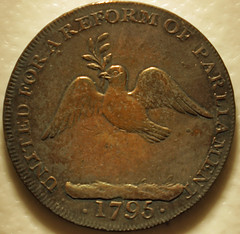

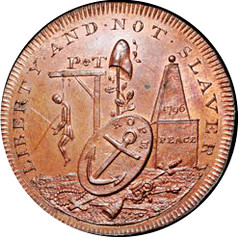
To read the earlier E-Sylum article, see:
NUMISMATIC NUGGETS: JULY 1, 2018 : 1795 London Corresponding Society Token
(http://www.coinbooks.org/v21/esylum_v21n26a23.html)
Chinese Sycee Bullion Pieces
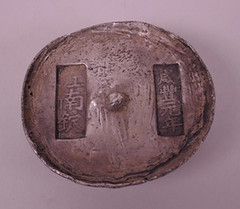
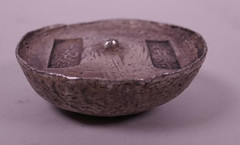
Howard A. Daniel III writes:
The Chinese White Metal Trade Token is silver bullion and not a token. It could have been made by a business or a financial institution. There are many different shapes and all are called Sycee but each shape has a name too. There are MANY replicas being sold worldwide which originally came out of China. The "white metal" in the description could mean that it is not silver, which is often the case with the replicas. I have seen them cut in half and the core is copper or another metal and there is a thick plating of silver around it. Do not buy these pieces without the advice of a trusted and advanced collector or dealer.
Ted Puls writes:
The Chinese ingot shown appears to be a sycee from the reign of Hsien Feng, from the province of Jiangnan. The Mitchner volume on Non-Islamic oriental coins references similar "boat" sycee from Yunnan Province. J. Cribb has written a book on this I believe (but I don't possess it) that may have more detailed references. Many fakes exist.
Ken Spindler of San Diego writes:
That object is a Chinese sycee - an ingot produced privately for use in large commercial transactions and for paying taxes, from melted-down foreign silver coins, with a uniform appearance for the place and time, impressed with the names of the assayers and/or bankers who assured their purity. Sometimes they specified their function. There are lots of shapes and sizes, and they were made for hundreds of years.
The vast majority of them trading between collectors today are from the 19th - early 20th centuries. They often appear in foreign-coin numismatic auctions, especially larger and older examples. There are probably several other references available to catalogue these with nowadays, but I used to do so for the auction house I worked for 10+ years ago using the British Museum's large volume covering their collection.
I refer you to the article on sycee contained in 1801-1900 Standard Catalog of World Coins under China (at page 189 of my 8th edition), and oodles of them appear in (the must-have) Charles J. Opitz, An Ethnographic Study of Traditional Money.
To read the earlier E-Sylum article, see:
NUMISMATIC NUGGETS: JULY 1, 2018 : Chinese White Metal Trade Token
(http://www.coinbooks.org/v21/esylum_v21n26a23.html)
Coin Hoards in English History
Jeff Garrett writes:
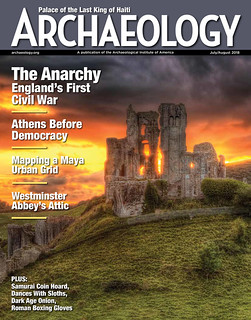 There is an interesting article in the July/ August 2018 issue of Archeology Magazine that mentions coins.
Inside the Anarchy discusses the importance of coin hoards in the study of English history circa 1150 AD.
There is an interesting article in the July/ August 2018 issue of Archeology Magazine that mentions coins.
Inside the Anarchy discusses the importance of coin hoards in the study of English history circa 1150 AD.
For more information, see:
https://www.archaeology.org/issues
Hawaiian Statehood Special Medal Set
Regarding the Hawaiian statehood medals,
Jan Monroe writes:
I believe there is another special medal set that was created perhaps as a salesman sample set that included sample medals with different metals and finishes for the purpose of deciding what the medals should be made of. I have one medal of that set that appears to be made of copper or a copper finish. Other medals would have included silver plated and gold plated medals among others. I discussed this with Donald Medcalf (Gordon Medcalf's son). He was aware of the set. I do not know how many medals were in the set. Gordon Medcalf, Robert Fong, Donald Medcalf, and Ronald Russell wrote the 1967, 1978, and 1991 books on Hawaiian Money and Medals.
With regard to the process set apparently only five complete sets were put together for the Gimbel store outlets as promotion items for the sale of the medals. They consisted of six medals including a blank planchet, 1st, 2nd, and third strikes; a trimmed medal (no finish), and a finished medal. (See Harmer, Rooke, Numismatists Ltd., The Andrew Faller Hawaiian Collection Treasure coins, March 26, 27, 28, 1975 page 13 Lot 257.)
To read the earlier E-Sylum article, see:
THE MISSPELLED HAWAII STATEHOOD MEDALS
(http://www.coinbooks.org/v21/esylum_v21n26a11.html)
Penalty Shootout Coin Proposed
David Pickup writes:
A few years ago the Royal Mint issued a 50 p to explain the football offside rule. I suggest they do one about penalty shootouts. (You will only understand that if you are a football fan).
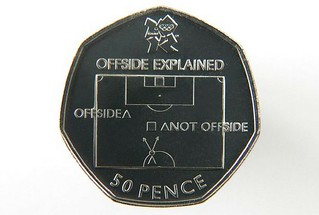
What. Just. Happened?
England fans have never experienced the feeling of winning a World Cup penalty shootout but the positive vibes that have carried Gareth Southgate's team so far continued on Tuesday night.
The Three Lions beat Colombia 4-3 in a shootout to reach the quarter-finals of Russia 2018.
To read the complete article, see:
World Cup 2018: England won a penalty shootout and the nation lost it
(https://www.bbc.com/sport/football/44705768)
To read the earlier E-Sylum article, see:
ARTICLE HIGHLIGHTS ROYAL MINT RARITIES : The 2012 London Olympics Coin
(http://www.coinbooks.org/esylum_v19n35a30.html)

QUERY: EAST INDIA COMPANY COIN FIELD PATTERN
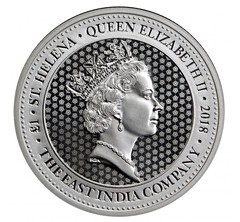
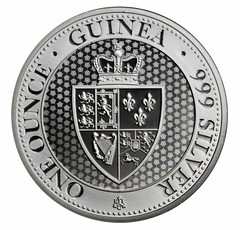
The government and treasury of St. Helena, in association with the East India Company, have issued a new silver coin that launches the bullion coin programme which will be under the guidance of the East India Company. The new silver one-ounce coins, which are official legal tender in Saint Helena for one pound, includes a reverse design that features the historic shield that was depicted on the gold spade guinea – first issued in 1787 during the reign of King George III. The guinea denomination itself was first introduced by Charles II in 1663 and has the distinction as being the first English machine-struck coin. Originally worth one pound (or 20 shillings), over time its value fluctuated with the price of gold until 1717 when Britain adopted the gold standard and its value was fixed at 21 shillings.
The "spade" guinea was so-called due to the shape of the shield seen on its reverse which contained the various representations of the British Kingdom that resembled a shovel or spade. It is also noteworthy to mention that the coin's moniker of a "spade" may have alluded to the nickname of King George III who was known as "the farmer king" or "Farmer George" since His Majesty was known to prefer his time in the countryside tending to his gardens and also showed a keen interest in agriculture. The coat of arms, which is depicted on the new silver bullion spade guinea ounce coins, includes the crests representing the realms within the United Kingdom during the near 60-year reign of King George III.
The obverse bears the elegant effigy of Her Majesty Queen Elizabeth II created by internationally renowned sculptor Raphael Maklouf. The text around the Queen's portrait includes the name of issuing authority of St. Helena, the denomination £1, and the year 2018.
Both the obverse and reverse feature a distinct East India Company traditional pattern in the fields. The reverse bears the distinctive quality mintmark of the East India Company which is seen below the primary design. The East India Company and the government of St Helena have a long and historic association with the issuing of coinage, which was first issued in 1821.
To read the complete article, see:
East India Company Coin Field Pattern
(http://news.coinupdate.com/st-helena-and-east-india-company-new-silver-bullion-one-ounce-coin-features-historic-spade-guinea-motif/)
To read an earlier E-Sylum article about the East India Company, see:
A REVIVED EAST INDIA COMPANY STRIKES COIN
(http://www.coinbooks.org/esylum_v15n14a23.html)
THE WASHINGTON HALL OF FAME MEDAL
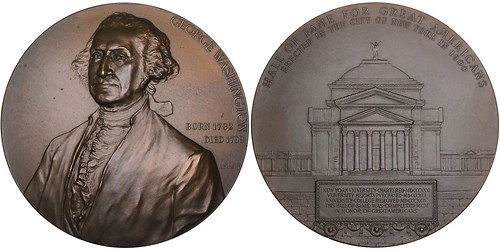
This medal honored the inauguration of the Hall of Fame and the building housing statues of the HoF inductees, all completed by the year 1900, the date of this medal. It was dedicated in 1901.
The building was originally the library on the campus of the New York University in the Bronx. The library was removed to a new building in 1972, leaving this building largely vacant, save for several university offices. It served as the site of the dedication ceremonies of new bust installations.
On the west side and extending on the north is the Colonnade with open segments where the busts of the HoF inductees are located. Of numismatic interests the majority of the sculptors of the busts were medallists, with coin engravers Augustus Saint-Gaudens, James E. Fraser, Laura Fraser, Hermon MacNeil, John Flanagan, and Chester Beach were among the bust artists,
The concept of the Hall of Fame was that of the first Chancellor, Dr. Henry Mitchell MacCracken. To his credit every aspect was well designed and executed. George Washington was the only inductee chosen by unanimous vote among 27 other inductees that first year,
It was an obvious choice to place Washington on this inaugural medal. It was to be high quality. Instead of making it in America MacCracken chose the Austrian Mint in Vienna, and Chief Engraver Anton Scharff (1845-1903) to create the medal.
It was struck in both silver and bronze. My silver version is one of my favorite possessions. As a medal dealer I sold six in bronze over a ten-year time.
The committee to name the new inductees met every fifth year, adding new Americas who met their concept of fame. Sculptors were commissioned to prepare bronze busts, these were installed in the Colonnade. Eighty-three had been chosen by 1960, 13 were added later.
Because of the popularity of collector medals in the 1960s a consortium of four organizations gathered to sponsor a series of medals of the Famous American inductees at the HoF. In eight years 3-inch medals were struck in bronze, 1 ¾-inch in bronze and silver of all 93 inductees.
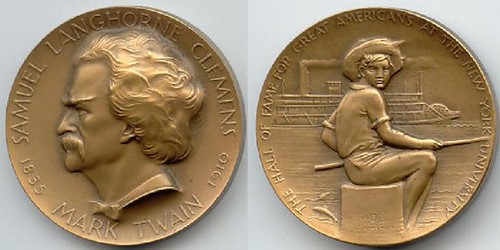
Samuel Langhorne Clemens (Mark Twain) medal
The consortium consisted of New York University, which owned the HoF, the National Sculpture Society, whose members created the medals, Medallic Art Company, to strike the medals, and Coin & Currency, to market them.
The medals were to contain a portrait of the Famed American, the reverse a scene signifying their accomplishment. Other than the University's name there were no other restrictions, allowing the artists free reign to be as creative as possible. The entire series consists of 93 medals; these are illustrated in my list of series on the Medal Collectors of America website.
The Washington medal was a forerunner of the Hall of Fame medal series, not connected to the series. The medal honoring the start of the series, in effect, the Keystone Medal (1960-060) was created by Donald DeLue in 3 ¼-inch size.
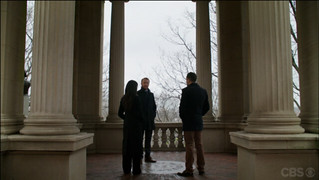 The public can tour the Colonnade during daylight hours, class tours are encouraged from nearby schools. The HoF has an administrator; I became familiar with three consecutive administrators in the years approaching the HoF's centennial. Together we prepared plans to raise revenue for the Hof by establishing a gift shop and selling the medals at the site.
The public can tour the Colonnade during daylight hours, class tours are encouraged from nearby schools. The HoF has an administrator; I became familiar with three consecutive administrators in the years approaching the HoF's centennial. Together we prepared plans to raise revenue for the Hof by establishing a gift shop and selling the medals at the site.
In 1973 New York University suffered financial trouble and sold the campus -- HoF included -- to New York State to be replaced by the Bronx Community College. Its new director was an academic administrator who had little interest in the HoF. She also had no desire for an entrepreneurial venture. To her profit was the antithesis of the grants and gifts received for the support of the College.
One of the ideas a HoF director and I had was to restrike that original Washington Medal, marking it in some way for the centennial. I contacted the Vienna Mint. Would you believe, they found the hundred-year-old dies in a museum! They were eager to work with us.
Unfortunately, our plan was rejected by Lady Administrator. You can't earn a profit for the Hall of Fame.
And today, the original Hall of fame is in limbo, as, perhaps twelve, fifteen hundred Halls of Fame exist in America, MacCracken did not trademark the name. His idea was so good it has been widely adopted. It is in public domain for anyone to use.
To read the earlier E-Sylum articles see:
HALL OF FAME FOR GREAT AMERICANS MEDALS
(http://www.coinbooks.org/esylum_v19n23a23.html)
MORE ON HALL OF FAME FOR GREAT AMERICANS MEDALS
(http://www.coinbooks.org/esylum_v19n24a14.html)
MORE ON THE HALL OF FAME MEDALS
(http://www.coinbooks.org/esylum_v19n25a12.html)
MEDAL SELECTIONS FROM NUMISMAGRAM: AMERICANA : Washington Hall of Fame Medal
(http://www.coinbooks.org/v21/esylum_v21n26a22.html)
CENTRAL STATES SUSPENDS AUTHOR GRANT PROGRAM
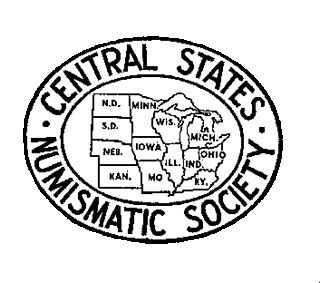 Bob Dylan once wrote, "The times they are a changing…" Like our times, our education programs are changing as well. After analysis and review, the board has voted to suspend some programs that were shown to be less than cost effective and some that were shown to be less popular with our membership. The programs suspended are: The Library Book program, The Author Grant program and the Traveling Seminars.
Bob Dylan once wrote, "The times they are a changing…" Like our times, our education programs are changing as well. After analysis and review, the board has voted to suspend some programs that were shown to be less than cost effective and some that were shown to be less popular with our membership. The programs suspended are: The Library Book program, The Author Grant program and the Traveling Seminars.
The programs that we will be continuing have shown to have your support and also effectively share our educational mission. The continuing programs are: The Club Speaker program and The DVD program.
At the convention we will also continue our very popular and well supported speaker programs. The Heritage Educational Forum will continue due to the substantial sponsorship by Heritage Auctions. We will also continue our popular exhibit area at the convention. And, we are excited to announce an addition to our education offerings at the convention. The History in your Hands Foundation, a Chicago based numismatic educational organization, will be leading our programs for beginning and young collectors.
It's been said that "No one likes change". That may very well be true. Change is hard. It upsets the status quo and the things of which we have become familiar. Yes, the times they are a changing… and even though change is hard to accept, this change is necessary.
Mitch adds:
This was a tough decision for our board. It was not easy suspending this program knowing the benefit that these grants have afforded numismatic authors over the years. However, knowing the many authors that have benefited from the program, and the many readers who have enjoyed their works, I can only hope we can find sponsors to fund the program in the future so it can be re-instated.
For more information about the Central States Numismatic Society, see:
http://www.centralstates.info/
To read an earlier E-Sylum article, see:
CENTRAL STATES AWARDS 2016-2017 AUTHOR GRANTS
(http://www.coinbooks.org/esylum_v19n41a04.html)
ï»
VOCABULARY TERMS: SO-CALLED DOLLAR, SOUVENIR MEDALS
Jeff Shevlin's article in last week's E-Sylum included his definition of so-called dollars. He said "So-called dollars are historical U.S. medals that commemorate a person, place or event in the United States history. They are 33mm to 45mm in size." There is more, of course, so I have chosen the term for this week in The E-Sylum for readers to respond. I agonized for years for a better definition than the half-page long one in the 1963 standard work by Hibler and Kappan. Shevlin boiled their definition down to two lines.
It was not until I studied similar items – gedinkthalers in Germany and jettons in France – did I realize the one factor that made them different from other medals -- they were struck on coining presses as were coins. So-called dollars are coin-medals.
Since the term "so-called dollar" is so fuzzy and indistinct I believe it should be replaced with a more accurate term – say Souvenir Medal. So I have added it to today's terms. It would not eliminate any existing medals from those already assigned and listed in HK, but would, in fact, add more varieties, as a larger medal to the dollar size of so-called dollars.
If you have an opinion whether to change the use of the term "souvenir medal" for "so-called dollar" please e-mail me at dick.johnson@snet.net and copy Wayne Homren. A discussion in The E-Sylum would be a useful start.
So-called Dollar. Originally political medals struck in silver similar to a United States silver dollar including such items as Bryan dollars (1896, 1900) and Lesher or Referendum dollars (1900–1901). Later the term was corrupted to include any medal similar in size and relief – but not necessarily similar in composition – to the U.S. silver dollar (1 1/2-inch or 38mm) or gold dollar (14mm). The term is similar in concept to a German word, GEDENKTHALAR, a coin-like medal in similitude to the large silver coins of three or five-mark denomination, and to the French word, JETTON, for a small, coin-size medal. True so-called dollars are indeed COIN-MEDALS, struck on a coining press, utilizing equipment normally used for striking large coins: UPSETTING (rimming) machines, blanking dies, collars and such.
There was no problem utilizing exact diameters of existing coins when these medals were issued for the U.S. centennial of 1876 and for the Columbian Exposition of 1892-93, nor for the political medals of 1896-1901. Silver dollar-size vending machines and turnstiles did not exist at that time but with the rise of this industry in the 20th century, slug laws were enacted to prohibit the manufacture of coin-like pieces that would work in these machines.
These problems were noted as early as 1904 when the round Louisiana Purchase Exposition coin of admission (HK 305) was replaced by the octagonal varieties (HK 306 and 307). The round variety was too similar to a silver dollar. Later, in 1939, the Manufacturers Trust Company, a bank which obtained the contract to issue the official medal of the 1939-40 New York World's Fair, changed from its original intention for a round medal to an oval one (HK 491) just because of their concern with these slug laws.
The term "so-called dollar" is not precise and current usage has further corrupted it to include a wide variety of medals from 33 to 45mm diameter (including commercial, fair and exposition pieces, and others). To clarify the term, it should be employed to include only those medals of the above-mentioned diameters struck in a coining press , and exclude art medals of any size. See COIN-MEDAL, SOUVENIR MEDAL, COMMEMORATIVE MEDAL, GEDENKTHALER, JETTON.
CLASS 01
References: O16 {1963} Hibler and Kappen
Coin-medal. A medal made like a coin – struck in a coining press on an upset blank with low-relief coining dies. The appearance of a coin-medal is like that of a coin in every aspect, it just does not have a denomination and is, of course, not intended as money. The similarity between coin-medals and coins include size, method of manufacture, type and height of relief, composition, and some technical factors, like the presence of a rim (from UPSETTING) and the option to have a smooth or REEDED EDGE (from the type of COLLAR). Coin-medals are also like coins in that they may – or may not – have a proof surface; they differ in that sometimes they are given a patina finish rather than remain COIN FINISH.The original concept of SO-CALLED DOLLAR in the United States and GEDENKTHALER in Germany, was that these numismatic objects were coin-medals, as close to coins as possible, but without denomination and status of a circulating medium. Both so-called dollars and gedenkthalers were in imitation of large silver coins – the U.S. silver dollar, and the German three- or five-mark coin.
There are several inherent reasons for the popularity of a struck piece of this size (approximately 38mm or 1 1/2 inches): (1) convenience – it is a large coin and a small medal in one size; (2) design size – it is ample size for the designer to express his artistic design; (3) but most important of all, the machinery for producing such pieces is readily available, high-speed coining presses, upsetting machines and others, all could easily accommodate this size piece.
Thus what began as an imitation of a silver-dollar size coin around the turn of the 20th century became somewhat standardized for souvenir medals, collector medals – and the boom of the 1960s in America – the proof finish silver medal. All are medals, but closely resemble coins. See SO-CALLED DOLLAR.
CLASS 01
Souvenir Medal. A medallic memento; a medal issued in honor of a public celebration or event. The occasion of the event can be anything: an anniversary, dedication, fair, exposition, coronation, inauguration, launching or any such public celebration. The medals issued upon the completion of a public project – roadway, bridge, tunnel, dam or such – all fall within this category. Souvenir medals are often sold to the public or given to some participants. They fall within the large class of COMMEMORATIVE MEDALS, and become permanent historical mementos of the celebration.
For the original owners, possession of such a medal recalls their personal involvement – their participation, or attendance, or sheer endorsement of the event, its sponsor, or its subject matter. Souvenir medals are significant for the historical information they provide. We know of the date of the first step on the moon by man, or the delayed coronation of King Edward VII or the completion of the Alaskan pipeline – or thousands of events in history – because of permanent medallic memorials issued for these events.
Souvenir medals – like all commemorative medals – are a broad category of medallic art, in contrast to those award, prize or recognition medals given to recipients, or to medals of purely artistic or commercial nature. Souvenir medals are also very similar to HISTORICAL MEDALS because they almost always bear a date. Likewise they include all the medals known as SO-CALLED DOLLARS.
CLASS 12.6
Jeff Shevlin responds:
Dick's comments are very appropriate.
Part of a complete definition of what is a so-called dollar includes what is not. For example religious medals, military medals, athletic medals, award medals, store cards and advertising pieces are not considered so-called dollars.
JEFF SHEVLIN AWARDED ORDER OF THE PEACOCK
Dick Johnson adds:
Jeff Shevlin has earned the Order of the Peacock for catching errors in a draft of today's E-Sylum article. I bestow this coveted award to the first reader who responds to an error they have found in one of my E-Sylum articles. This is only the third time such award has been made in, perhaps, 1,500 E-Sylum articles, so my batting average is "purdy good."
I applaud the readers of The E-Sylum. You are the cream of numismatics, your knowledge of the field is outstanding. Any misstatement or factual error is immediately recognized and cause for response. For statements of opinion may cause a reader to have a different opinion. Certainly, a response is welcomed and may be the cause for a lively discussion.
Wear the Order of the Peacock with pride, Jeff. It is a rare numismatic decoration.
Looking for the meaning of a numismatic word, or the description of a term? Try the Newman Numismatic Portal's Numismatic Dictionary at: https://nnp.wustl.edu/library/dictionary
Or if you would like a printed copy of the complete Encyclopedia, it is available. There are 1,854 terms, on 678 pages, in The Encyclopedia of Coin and Medal Technology. Even running two a week would require more than 19 years to publish them all. If you would like an advance draft of this vital reference work it may be obtained from the author for your check of $50 sent postpaid. Dick Johnson, 139 Thompson Drive, Torrington, CT 06790.

OTHO JACOB BIERLY (1871-1957)
 Otho Jacob Bierly (1871-1957), was born on October 15, 1871, at Funkstown, Washington County, Maryland, son of Jacob H. Bierly (1847-), a blacksmith and a native of Hagerstown,Washington County, Maryland, and Mary Ellen Leckrone (1851-), also a native of Hagerstown, Washington County, Maryland.
Otho Jacob Bierly (1871-1957), was born on October 15, 1871, at Funkstown, Washington County, Maryland, son of Jacob H. Bierly (1847-), a blacksmith and a native of Hagerstown,Washington County, Maryland, and Mary Ellen Leckrone (1851-), also a native of Hagerstown, Washington County, Maryland.
In the 1896 Baltimore City Directory he is listed as a motorman living at 610 North Monroe Street, Baltimore, Maryland.
In the 1899 Baltimore City Directory he is listed as a manager at 503 West Franklin Street, Baltimore, Maryland.
He joined the ANA in November 1900, and became ANA Member No. 210.
In 1901, he is listed in Wallace's American Trotting Register, as the owner of Ella Cain, a thoroughbred Mare, at Funkstown, Maryland. Sometime in 1901, he moved to Pittsburgh, Pennsylvania.
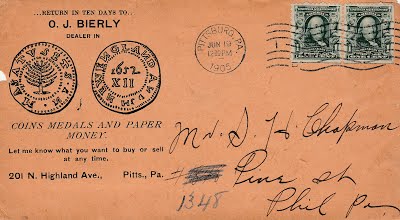
O. J. Bierly correspondence with Samuel H. Chapman
In April 1902, he applied for membership in the A.N.A. and in May became ANA Member No. 210. He lived at 122 St. Clair Street, Pittsburgh, Pennsylvania.
In 1905, his address was 201 North Highland Avenue, Pittsburgh, Pennsylvania.
In June 1914, he was a graduate of the Emory Brother hood Bible Class, at Emory Methodist Episcopal Church, Highland Avenue and Rippey Street, Pittsburgh, Pennsylvania. He was one of 46 police officers to take the bible course and graduate.
In the 1915 Pittsburgh City Directory he is listed as a Policeman living at 5917 Rippey Street, Pittsburgh, Pennsylvania.

Otho J. Bierly correspondence with Farran Zerbe postmarked January 4, 1909
In 1936 he moved back to his native Funkstown and lived with his sister Annie (1889-), and brother-in-law John White Johnson (1881-) at their home on Baltimore Street.
In August 1956 he was hospitalized at Washington County Hospital and released.
He died on December 12, 1957 at Hagerstown, Washington County, Maryland.
To read the complete article, see:
BIERLY, OTHO JACOB
(https://sites.google.com/a/numismaticmall.com/www/numismaticmall-com/bierly-otis-j)
John adds:
I wonder if Otho Jacob Bierly is related to Bill of the Central States Numismatic Society, who does the In God We Trust research?
I reached out to Bill, who writes:
I was not aware of Otho Jacob Bierly, but now that you raise his name and some information about him, I strongly suspect that I am related to him. The Bierly family came out of Pennsylvania so the Pittsburgh connection makes sense. Also the majority of the family were Methodists in that era. I will try to do some digging and see if I can find the exact connection, but I would bet that we are related.
The entire inventory of the Lupia Numismatic Library is for sale. Individual items will be available before the remaining archives are broken up into parcels sold at philatelic auctions in the U. S. and Hong Kong. Check NumismaticMall.com frequently as dozens of new items with estimates will be posted daily until everything is sold.
All inquiries will be given prompt and courteous attention. Write to: john@numismaticmall.com .
QUERY: A ZERBE-HEEREN CONNECTION?
I used to live in Pittsburgh PA and am interested in researching the Heeren Bros Company of Pittsburgh PA. I've read a TAMS Journal article from 1982 and a Numismatist article from 2004 and have seen an ANA video on the subject from when the ANA was in the 'burgh in 2011.
I was wondering if you kept up with any of the latest info on that jeweler/medal producer? I saw that an auction lots sold by Dr. Fanning containing Heeren Bros items in the last decade.
Part of my interest is the fact that I collect so-called dollars, and I am trying to figure out if there is a connection between Zerbe, Heeren Bros, and the 1904-05 small gold dollars that he sold. Zerbe lived near Pittsburgh PA around the turn of the century (1890s-1900s) when Heeren was quite active.
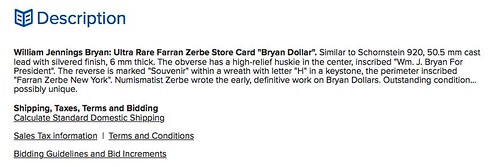
I already know of one connection. I purchased the attached medal (Zerbe store card) in a recent Heritage auction which is an unlisted possibly unique silver-plated lead trial for Zerbe as well as being a Bryan piece, not listed in Schornstein. The reverse of the medal is clearly a Heeren Brothers design, not recognized as such in the original lot description (also attached). The reverse design is similar to R-PIT-4A. So, it really makes me wonder what other connections exist...
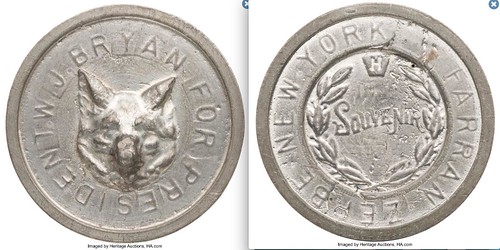
I would appreciate any ideas or directions for research in this area.
INDIANA STATE MUSEUM HEEREN BROS COLUMBIA SHIELD
David Buchanan, Curator, Decorative Objects and Furniture, Indiana State Museum and Historic Sites writes:
I'm very appreciative in reading the information in your web-publication as to the Columbian Shield created by the Heeren Brothers.
We have one in our collection, one which has been hanging in our storage for years with almost zero information in its record. We don't even know when it came in to the collection. But it is also the type of object where we wouldn't be surprised if a newspaper article surfaces with its Indiana related information, something which has happened a number of times in the past. Now at least, thanks to you and your readers, I can put in the manufacturing history even if I don't have the specific Indiana story.
I've no idea if it might be possible to get a notification if any more of these surface or any more information is found but if so, I'd love to learn of it.
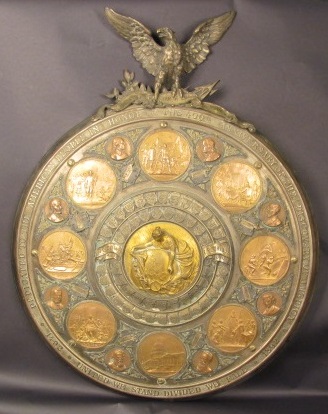
From the collection of the Indiana State Museum and Historic Sites
To read earlier E-Sylum articles, see:
QUERY: THE HEEREN BROTHERS COLUMBIA SHIELD
(http://www.coinbooks.org/esylum_v15n36a10.html)
MORE ON THE COLUMBIA SHIELD
(http://www.coinbooks.org/esylum_v15n37a12.html)
HEEREN FAMILY BACKGROUND ON THE COLUMBIA SHIEL
(http://www.coinbooks.org/esylum_v18n23a22.html)
ANOTHER COLUMBIA SHIELD LOCATED
(http://www.coinbooks.org/esylum_v19n08a16.html)
VIDEO: EAC REMEMBERS R. TETTENHORST
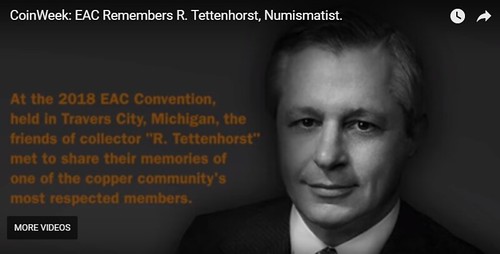
Collector R. Tettenhorst–real name Bernard Alan Edison–built an amazing collection of half cents and was a revered member of the copper collecting community. Edison was born in St. Louis, Missouri on March 23, 1928. He was a scion of the Edison family, who founded the famous Edison Brothers shoe store chain.
At the 2018 EAC Convention, several members of Early American Coppers (EAC) gathered to discuss some of their fondest memories of "Tett" and the impact he made on their lives. In the video above, CoinWeek editor Charles Morgan speaks to the EAC's Bill Eckberg, Denis Loring, Harry Salyards, Bob Kebler, and Mike Packard.
To read the complete article (and watch the video), see:
CoinWeek: EAC Remembers R. Tettenhorst, Numismatist
(https://coinweek.com/dealers-companies/eac/coinweek-eac-remembers-r-tettenhorst-numismatist/)

SUMMER SEMINAR BOOK SALE FINDS
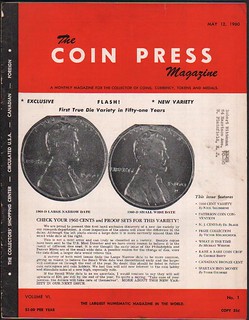 Each year I teach a class at the ANA's Summer Seminar, and one of the most anticipated events for all is the fund-raising book sale at ANA headquarters. It kicks off Saturday evening, after student registration and the seminar orientation. Everyone is eager to secure a low number for entry into the book sale room, as occupation within this small space is rationed for safety. There's always a mad scramble for those who get in the earliest, and there are often some pretty nice books and catalogs that go for a fraction of their values at auction.
Each year I teach a class at the ANA's Summer Seminar, and one of the most anticipated events for all is the fund-raising book sale at ANA headquarters. It kicks off Saturday evening, after student registration and the seminar orientation. Everyone is eager to secure a low number for entry into the book sale room, as occupation within this small space is rationed for safety. There's always a mad scramble for those who get in the earliest, and there are often some pretty nice books and catalogs that go for a fraction of their values at auction.
Since my library is pretty much complete for all the titles I'd want or need, I typically bypass that first session altogether. I do like bonding with students and my fellow instructors, but not in quite such a physical manner, as the room becomes all elbows and knees in a matter or moments.
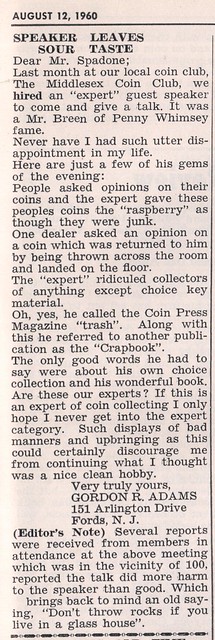 The book sale reopens the next day during lunch time, and that's when I make my first pass. There's never a concern that I've missed something important, as I seek the items that others leave behind. My purchases consist of popular, unscholarly hobby magazines, dealer buying guides and ephemera of the sort that sells for 25 cents apiece (by the last day of the sale, prices have been slashed to the point where $5 will buy as much as one can carry). These are the bits of numismatic literature that tell me the where, when and how much of coin folders, albums and gadgets that I collect as hobby history and use for researching my own books.
The book sale reopens the next day during lunch time, and that's when I make my first pass. There's never a concern that I've missed something important, as I seek the items that others leave behind. My purchases consist of popular, unscholarly hobby magazines, dealer buying guides and ephemera of the sort that sells for 25 cents apiece (by the last day of the sale, prices have been slashed to the point where $5 will buy as much as one can carry). These are the bits of numismatic literature that tell me the where, when and how much of coin folders, albums and gadgets that I collect as hobby history and use for researching my own books.
During this year's event I scored a long run of The Coin Press, a decidedly unsophisticated monthly published by Frank Spadone in East Orange, New Jersey. The issues run from 1959 through the end of 1961, when this title was purchased by Krause Publications. Initially, just the "The" was dropped from the title, but it re-emerged as COINS Magazine with the first issue of 1962 and continues as such to the present day.
I found some real nuggets that will be of interest. These include an early photo of Q. David Bowers with Empire Coin Company partner Jim Ruddy, as well as the first publication of the Large Date/Small Date varieties of 1960 cents which topic came to dominate all the remaining issues of 1960 in this and other popular journals. Best of all, perhaps, is a scathing report of Walter Breen's speaking engagement at the Middlesex Coin Club in New Jersey. A more unlikely setting could not be imagined, as the members were likely all focused on BU rolls, proof sets and BIE Lincolns, much to the disgust of prickly scholar Breen.
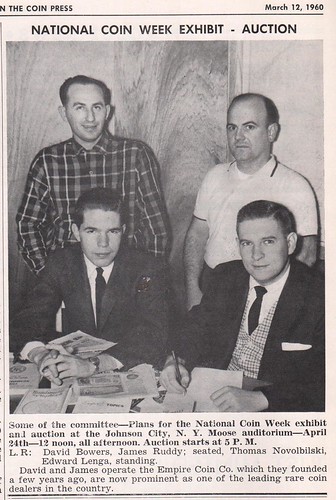
WHICH NAPOLEONIC MEDALS DID PEALE SEE?
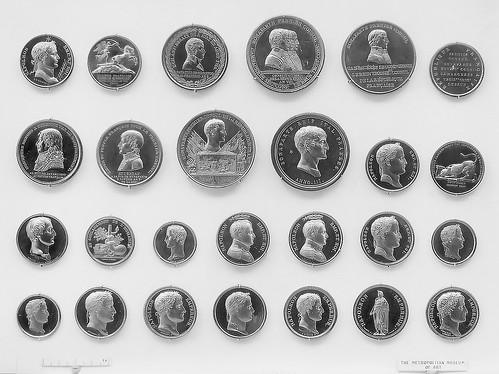
FINALLY!!! I've been trying for years to figure out which Napoleonic medals Franklin Peale saw being made at the Paris mint in 1833/34. He mentions them in his 1835 Mint report and, if I recall, in a letter back to Moore, but it's just an off-hand comment about the Paris mint striking a large run of Napoleonic medals (I have to re-find the exact quote).
Everyone I've asked for years has responded that it would be nearly impossible to tell since the French frequently struck and restruck all sorts of Napoleonic medals.
Anyway, I met Bill Goetz, who specializes in French medals and coinage, at the Baltimore show and he suggested the Arc de Triomphe series. That proved to be a no-go as the dates were a little later. However, that lead me to Mssr. Nicolas Guy Antoine Brenet, who did quite a bit of work for the French mints, including a series of 20 Napoleonic medals which were exhibited at the 1833 Paris Salon (see PDF).
Then I found a set of 26 gilt bronze Napoleonic medals by Brenet in the collection of The Metropolitan Museum of Art (see photos). I've emailed Dr. Thayer Tolles of The Met and Bill to see if we can ID the 1833 Paris Salon pieces and get more info on the gilt set. That's probably a gift or diplomatic set. The "extra" pieces may be earlier or later medals by Brenet as he did exhibit at several Paris Salons. Or he may simply have chosen 20 of the pieces for exhibit and the 6 "extras" simply represent the full range being struck.
Either way, we finally have a solid view of what Peale saw and yet another object lesson in why it pays to keep digging even when everyone else thinks you're chasing the impossible. Plus, I got another cool set to collect.
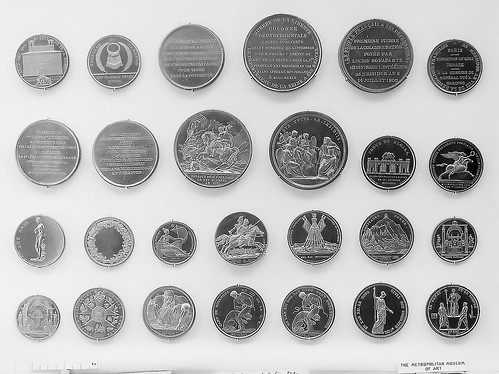
PAINTING RECREATES JEFFERSON'S COIN TRANSACTION
Paintings of scenes from American numismatic history have been created now for more than a century, but most artists have struggled to paint works of art that also get the history right. Steve Roach contributed a feature story, "Your Own Numismatic Masterpiece," to the July 16, 2018 issue of Coin World, telling how a newly-created painting has combined artistry with known historical facts. Author Joel J. Orosz commissioned artist Carlton Eddy of Helotes, Texas to paint a different kind of numismatic artwork, recreating, both aesthetically and accurately, an actual pivotal moment in the history of American numismatics.

Dunsmore: Washington Inspecting the First Money Coined by the United States
The most familiar American numismatic historical painting is "Washington Inspecting the First Money Coined by the United States," painted in 1914 by artist John Ward Dunsmore on a commission from Frank H. Stewart, who had owned the last three remaining buildings of the first United States Mint. Dunsmore was a first-rate artist, and "Washington Inspecting" is a beautiful work of art. As history, however, the painting is pure bunk, depicting, as it does, a group of people who mostly never visited the Mint, attending a ceremony that never occurred, all set in a Mint building that did not exist in 1792.
In the course of research for 1792: Birth of a Nation's Coinage, Orosz and co-authors Len Augsburger and Pete Smith discovered that Thomas Jefferson's Memorandum Book, a ledger of his personal household expenses, contained an extensive record of Jefferson's involvement with the creation and distribution of the first coin minted under the authority of the United States Constitution: the 1792 half disme.
The Memorandum Book detailed how Jefferson delivered $75 worth of silver to the Philadelphia Mint on July 11, 1792, and received 1,500 half dismes on July 13, just before leaving for his summer vacation at Monticello. The first overnight stay on the 10-day journey was at an Inn located in Chester, Pennsylvania, about 15 miles southwest of center city Philadelphia, where, as Jefferson noted in his Memorandum Book, he paid 30 cents to "servts" in tips.
This was the first unambiguously decimal transaction recorded in the Memorandum Book, and it means that these six 1792 half dismes Jefferson tendered comprised the first transaction using coins struck by the U.S. Mint: the first of many billions to come.
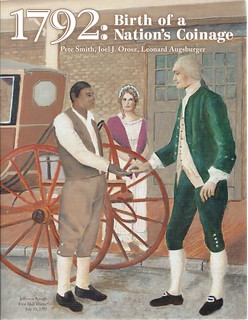 Co-author Pete Smith captured the moment of that first transaction, when Jefferson tipped the Inn's
porter those six half dismes, with Jefferson's daughter Maria looking on. Smith's oil painting, which
combines artistry and historical accuracy, is the cover art for 1792: Birth of a Nation's Coinage,
published by the Ivy Press, Inc. (a subsidiary of Heritage Auctions) in 2017. After the book appeared,
inspired by Smith's example, Orosz began a collaborative process with artist Carlton Eddy to recreate
the moment later in the evening of July 13, 1792, when Jefferson recorded the first transaction in his
Memorandum Book.
Co-author Pete Smith captured the moment of that first transaction, when Jefferson tipped the Inn's
porter those six half dismes, with Jefferson's daughter Maria looking on. Smith's oil painting, which
combines artistry and historical accuracy, is the cover art for 1792: Birth of a Nation's Coinage,
published by the Ivy Press, Inc. (a subsidiary of Heritage Auctions) in 2017. After the book appeared,
inspired by Smith's example, Orosz began a collaborative process with artist Carlton Eddy to recreate
the moment later in the evening of July 13, 1792, when Jefferson recorded the first transaction in his
Memorandum Book.
Eddy's oil painting depicts Jefferson seated in his room at the Inn, recording the day's events by glowing candlelight. Nearly every detail in the painting is modeled upon late 1790s originals, including Jefferson's travel box containing a set of coin scales. Jefferson's hand is visible making entries in the Memorandum Book, and Jefferson himself appears in the mirror on top of the table, where he is literally reflected, and also symbolically reflecting, on the significance of the day's momentous events. Half dismes spill from a pouch, and two have landed, obverse and reverse, on the open page of the Memorandum Book. More details about the Eddy painting, and on the process by which Orosz and Eddy co-created it, can be found in Steve Roach's July 16, 2018 Coin World feature story.
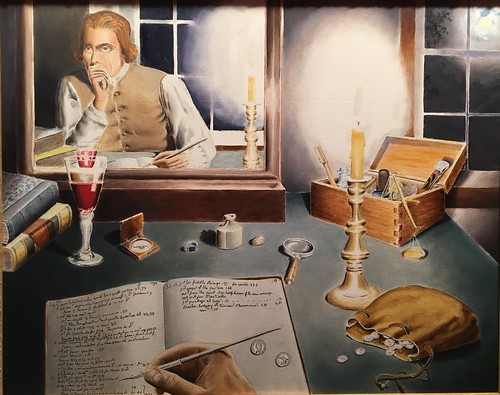
Eddy: Thomas Jefferson, Evening, July 13, 1792, Chester, Pennsylvania
Carlton Eddy has been an official Coast Guard artist since 1988, and regularly paints aviation subjects for the U.S. Navy. Over the past few years, his artistic ambit has expanded to include numismatics, depicting coins, especially in historical settings. Eddy's clients have included Heritage Galleries and professional numismatists around the nation. His work is on display at, among other museums, those of the U.S. Naval Academy, and the National Museum of Naval Aviation in Pensacola. He may be reached at: sketcheddy@yahoo.com
The co-authors have created a new edition of 1792: Birth of a Nation's Coinage, limited to only 14 copies, featuring the Eddy painting, "Thomas Jefferson, Evening, July 13, 1792, Chester, Pennsylvania" as the cover art, with the Smith painting, "The First U.S. Coin Enters Commerce, Chester, Pennsylvania, July 13, 1792," as the book's frontispiece. Thirteen numbered copies have been distributed to the co-authors and to those who were especially helpful with the book's research and publication. One numbered copy will be offered as part of the Numismatic Bibliomania Society Benefit Auction, to be held on August 17, 2018, at the NBS annual meeting during the 2018 ANA Convention.
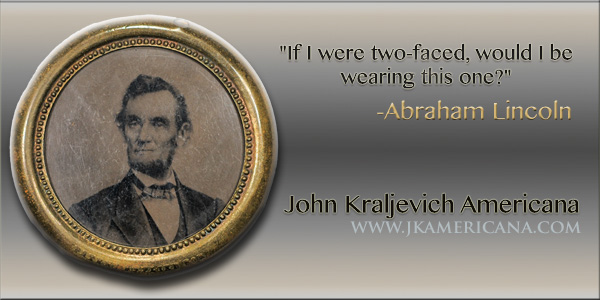
TAMS MEETING AND BANQUET IN PHILADELPHIA
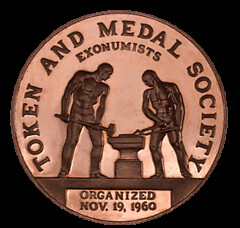 As we prepare for the ANA's World's Fair of Money to be held in Philadelphia from August 14-17, TAMS is excited to announce that plans are falling into place for our usual Wednesday meetings and banquet. Below are the specifics – plan to attend!
As we prepare for the ANA's World's Fair of Money to be held in Philadelphia from August 14-17, TAMS is excited to announce that plans are falling into place for our usual Wednesday meetings and banquet. Below are the specifics – plan to attend!
Wednesday, August 15
Board meeting Room 121A
Philadelphia Convention Center 8:00 a.m.
General Membership Meeting Room 117
Philadelphia Convention Center 1:00 p.m.
Speaker will be Ernie Nagy, incoming TAMS
president, on the "Satire of Hard Times Tokens"
TAMS Banquet - hosted at Maggiano's Little Italy, 1201 Filbert St., Philadelphia
Tickets - $50.00 per person – includes a fabulous meal + door prizes, an auction, and the awarding of the Mishler Cataloging Awards and the Schenkman and other Literary Awards.
Begins at 6:30 p.m. We have 50 spots for reservations, so you will want to make sure you get your reservation to Kathy Freeland early. Please note that checks will not be cashed until after the banquet, so if you want to just call or e–mail with a reservation, that is fine as well, as long as you pay either prior to or at the dinner.
Meal will include beverage of choice (no alcohol, although there will be a cash bar just outside the banquet room), Classic Bruschetta, Chopped Salad and Chopped Apple & Walnut Salad, Lasagna, Spaghetti with Meatballs, Chicken Parmesan, Tilapia, Tiramisu and a fresh fruit plate.
If you have auction items you would like to donate to the society, please contact Kathy Freeland as well.
Kathy Freeland – PO Box 195, Mayville, MI 48744
Phone Number – 989-843-5247
E-Mail ksfdaf@sbcglobal.net
For more information on TAMS, see:
http://www.tokenandmedal.org/
NUMISMATIC NUGGETS: JULY 8, 2018
1771 North Carolina Five Shillings

Early American currency went through several stages of development in colonial and post-Revolutionary history of the United States. Because few coins were minted in the thirteen colonies that became the United States in 1776, foreign coins like the Spanish dollar were widely circulated. Colonial governments sometimes issued paper money to facilitate economic activity. During the American Revolution, the colonies became independent states; freed from British monetary regulations, they issued paper money to pay for military expenses. The Continental Congress also issued paper money during the Revolution, known as Continental currency, to fund the war effort.
One by one, colonies began to issue their own paper money to serve as a convenient medium of exchange. In 1690, the Province of Massachusetts Bay created "the first authorized paper money issued by any government in the Western World." This paper money was issued to pay for a military expedition during King William's War. Other colonies followed the example of Massachusetts Bay by issuing their own paper currency in subsequent military conflicts.
To read the complete lot description, see:
1771 Five Shillings - North Carolina Colonial Currency Note
(https://www.pristineauction.com/a1625174-1771-Five-Shillings-North-Carolina-Colonial-Currency-Note)
1783 Peace of Versailles Medal
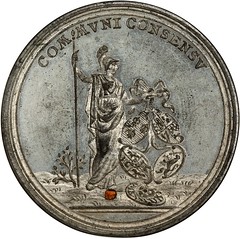
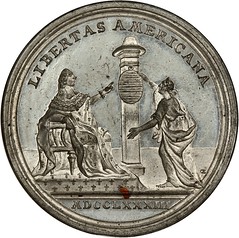
1783 Peace of Versailles, Libertas Americana French Medal NGC MS62 (Betts-608)
A fascinating piece made in a white metal. Closely related to the famous Libertas Americana medal, this piece was struck to commemorate the Peace of Versailles, ending the Revolutionary War.
To read the complete lot description, see:
1783 Peace of Versailles, Libertas Americana French Medal NGC MS62 (Betts-608)
(https://www.davidlawrence.com/rare-coin/151108)
1853 $2.50 Gold Liberty Love Token

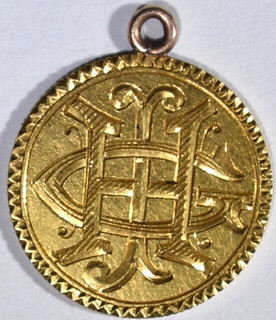
To read the complete lot description, see:
1853 $2.50 GOLD LIBERTY LOVE TOKEN
(http://www.silvercityauctions.com/1853-2-50-GOLD-LIBERTY-LOVE-TOKEN_i30636652)
Chinese Prancing Horse Gaming Token
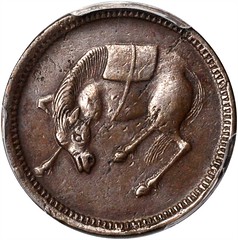
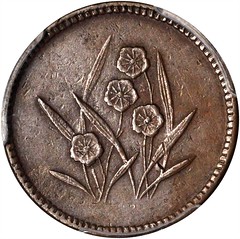
CHINA. Szechuan. 5 Cent Horse Gaming Token, ND (ca. 1912). PCGS AU-55 BN Secure Holder.
Duan-2281var. (2011 edition); Duan-3621(2005 edition). Struck in copper. Obverse: prancing horse; Reverse: spray of orchids. Lovely oxblood tone.
To read the complete lot description, see:
60265 CHINA. Szechuan. 5 Cent Horse Gaming Token, ND (ca. 1912). PCGS AU-55 BN Secure Holder.
(https://auctions.stacksbowers.com/lots/view/3-BF79M)
Chinese 5 Cash Commemorative Token
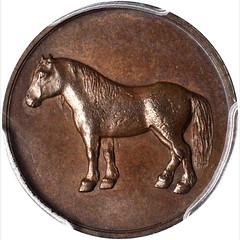

CHINA. Szechuan. 5 Cash Commemorative Token, ND (ca. 1918). PCGS MS-63 BN Secure Holder.
CL-Unlisted; Y-Unlisted; CCC-Unlisted; cf. Duan-3627. Struck in copper, reverse blank (not uniface). It is theorized that the production of these pieces was ordered by a high ranking official, thought to be the director of the Tientsin mint, in 1918 the lunar year of the horse to commemorate the birth of his new son. Three denominations were made (5 Cash, 10 Cash and 20 Cash), but due to their intricate high relief designs the reverses were left blank. The dies were produced by die-sinking and hubbing presses rather than the normal coining press. The following year in 1919(Year of the Goat) silver tokens were made to commemorate the birth of a new baby girl(see L&M-1000A). Horse is well struck up with tender detail, both sides deep brown.
Ex: R. B. White.
Ex: Lockhart. -Editor
To read the complete lot description, see:
60526 CHINA. Szechuan. 5 Cash Commemorative Token, ND (ca. 1918). PCGS MS-63 BN Secure Holder.
(https://auctions.stacksbowers.com/lots/view/3-BF4EE)
1935 Connecticut Half Dollar
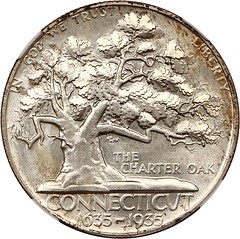
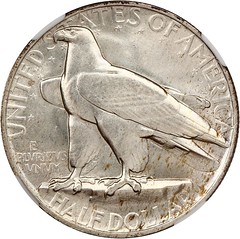
To read the complete lot description, see:
1935 Connecticut 50c NGC/CAC MS66
(https://www.davidlawrence.com/rare-coin/1533394)
Gold One Celeston Set
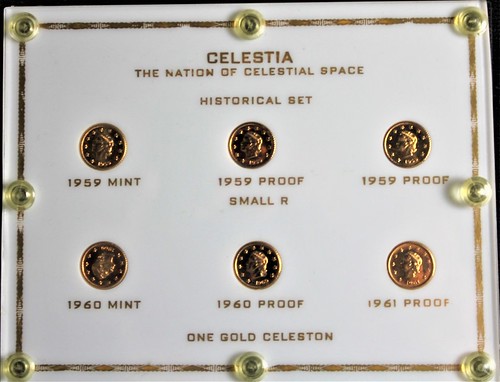
Celestia - The Nation of Celestial Space Historical 6 Piece Set
1959 token struck in 0.900 fine gold by James Thomas Mangan for the "Nation of Celestial Space" (Celestia for short). Mangan laid claim to all of space in Jan 18, 1949. The obverse shows Ruth Mangan, James Mangan's daughter with "MAGNANIMITY" on the head band. Apparently there are 4 total varieties: 1959 and 1960 UNC (as shown) and 1960 and 1961 proof (not seen). The reported mintages are 540 in 1959 and 200 in 1960.
To read the complete lot description, see:
Celestia - The Nation of Celestial Space Historical 6 Piece Set
(https://www.ebay.com/itm/Celestia-The-Nation-of-Celestial-Space-Historical-6-Piece-Set/173206378030)
To read an earlier E-Sylum article, see:
FEATURED WEB PAGE: NATION OF CELESTIAL SPACE
(http://www.coinbooks.org/esylum_v16n07a31.html)
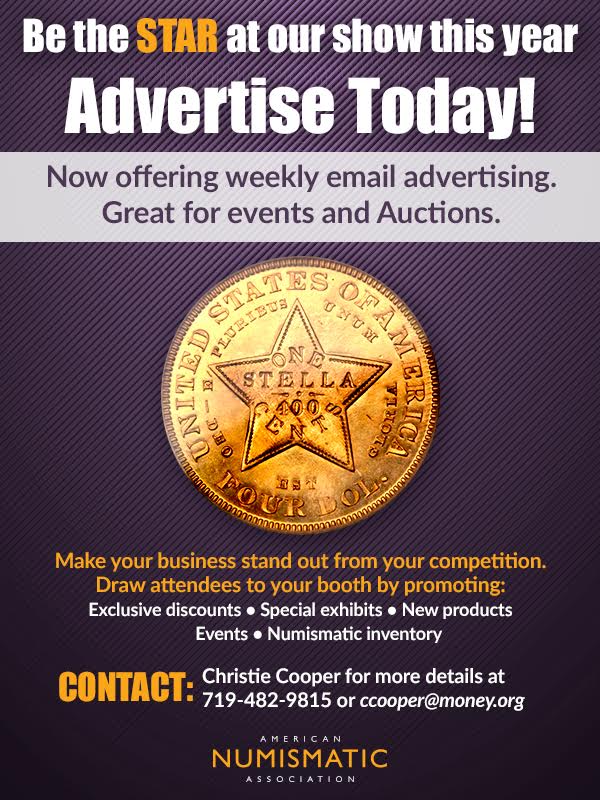
ROMAN COINS FOUND AT VULCI
 An exceptional discovery was made at the Vulci archaeological site, where a treasure of coins from the 3rd century B.C. was found intact, according to a statement from the site's scientific department.
An exceptional discovery was made at the Vulci archaeological site, where a treasure of coins from the 3rd century B.C. was found intact, according to a statement from the site's scientific department.
The discovery included 15 large bronze coins, which were likely originally stored in a leather bag.
They were found above the closing tile of a burial site together with an iron strigil (a tool that was used to clean the body) and numerous ceramics, all clearly part of a funeral ritual for two deceased.
One of those buried there, who was male, had another coin similar to the others placed on his left shoulder together with a bronze clasp, along with other objects in iron and ceramics that completed the burial kit.
His death may have been the result of an iron object, possibly a spear, found near the skull.
The second of the two buried there was cremated and the incinerated bones were wrapped in a shroud that was likely closed with a bronze clasp that was found next to it and was nearly identical to the other. Other objects were found in the vestibule of the tomb together with another burial, including a small circular pyx (chalice) with a lead cover.
The coins are part of the first Roman issue and have the prow of a boat on one side and the image of the god Janus Bifrons on the other, representing the passage of the dead from the world of the living to the underworld.
To read the complete article, see:
Treasure of coins found at Vulci archaeological site
(http://www.ansamed.info/ansamed/en/news/sections/generalnews/2018/07/03/
treasure-of-coins-found-at-vulci-archaeological-site_89467e5f-b991-4010-b0bf-9f4eaa937285.html)
HENRY VIII ANGEL SOUGHT IN MURDER INVESTIGATION
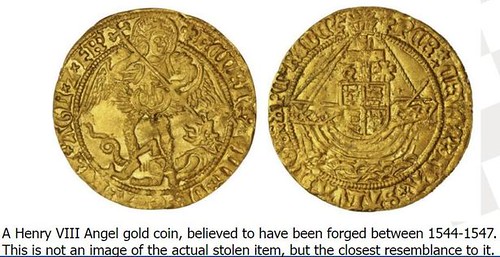
Police believe a rare 470-year-old coin may prove the key to snaring the savages who fatally injured a pensioner in his own home.
The reward for information leading to Arthur Gumbley's killers has been cranked up from £10,000 to £40,000.
Detectives believe items taken during the break-in may prove vital in cracking the case.
And the most distinctive of those is a Henry VIII Angel cold coin, forged between 1544 and 1547.
Arthur, a keen metal detectorist, uncovered the treasure while combing a field. Also taken was a House of Parliament pot and a unique gun-shaped knife.
Eight inches in length, one side is designed as a bayonette, the other a pistol with wooden handle.
Someone has possession of those distinctive items.
Arthur's daughter Sue Boys said: "We hope the coin will prove important because it is so different.
To read the complete article, see:
How rare coin could hold vital clue to murder of Arthur Gumbley
(https://www.birminghammail.co.uk/news/midlands-news/how-rare-coin-could-hold-14846786)
1982 NETHERLANDS-AMERICAN 50 GULDEN
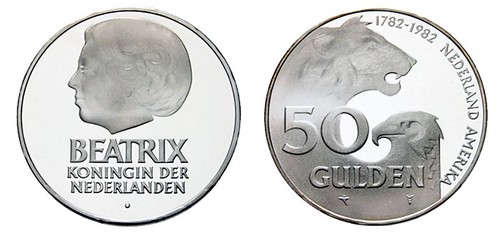
The Schulman Numismatists, auctioneers in Amsterdam, have included a scarce and very rare gold coin minted in 1982 which commemorated the 200th year of Dutch-American friendship that will go under the hammer on the 29th and 30th June. It is understood that the 50-gulden coin was presented to President Ronald Reagan for the occasion of the state visit of HM Queen Beatrix and HRH Prince Claus, which also marked the 200th year of friendship between the two countries.
The obverse carried an effigy of Queen Beatrix facing in the left direction with her legend placed below the portrait in three lines.
The reverse design integrated the symbols of the two countries into one conjoined design, the heads of a lion and an eagle, with the denomination of 50 GULDEN and the commemorative years 1782 – 1982 placed along the upper left edge. This anniversary coin was also the first time this denomination had been minted and was also released as a circulating sterling silver commemorative coin.
According to ex-employees of the Dutch State Mint, a total of six gold pieces were minted and placed in wooden presentation cases with the Dutch coat-of-arms. The actual mintage and how many pieces were disposed of have never been confirmed. To date, only this example has been seen in a public sale. It is understood this very coin was previously offered for sale by auction in 2016 and was written about in an educational article published in the Muntkoerier magazine by authors Jacco Scheper and Marcel van der Beek. The consignor acquired the coin in early September 2015 from Nancy Reagan's former designer, who worked with her to redecorate the White House.
To read the complete article, see:
1982 Netherlands-American 50 Gulden
(http://news.coinupdate.com/netherlands-and-united-states-exceptional-presidential-gift-of-scarce-gold-commemorative-coin-to-be-auctioned/)
IRAN'S SULTAN OF COINS
Iranian police have arrested a man they say hoarded two tonnes of gold coins in order to manipulate the local market.
Tehran police chief Gen Hossein Rahimi said the unnamed 58-year-old had used accomplices to collect an estimated 250,000 coins over the past 10 months.
He dubbed him the "Sultan of Coins".
Iranians have been buying up gold coins since the US abandoned a nuclear deal with Iran in May and said it would reimpose sanctions, triggering a fall in the value of the country's currency.
Two weeks ago, traders at Tehran's Grand Bazaar shuttered their shops and join protests in the capital prompted by the collapse of the rial and rising prices.
To read the complete article, see:
Iran's Sultan of Coins
(https://www.bbc.com/news/world-middle-east-44710012)

BLACK HOLE SPINNERS

Carrying this many Black Holes is not advised and extremely dangerous.
We did it.
A pocket sized black hole that can be carried with you. This is an actual black hole (it's not) that you can carry with you. If you're not aware, black holes are dangerous so please be careful near the event horizon because nothing can escape the gravitational pull of a black hole. The escape velocity of a black hole is faster than the speed of light which basically means that nothing can get away.
As a young boy, unlike most young boys, I couldn't have cared less about black holes, planets, solar systems or anything in our cosmos. I have no idea why, just didn't care. Recently (possibly my mid-life crisis), I've become more than fascinated with all things space. I'm not going to claim to be anything remotely close to an astrophysicist, astronomer or astro-anything for that matter. I can't even call myself an amateur astro-anything, but I learn something new every day and with every new bit of knowledge comes a dozen more topics I have to look up. The cosmos is too much. No, really, it's TOO much! Many of you already know this but for those of you that don't...look it up. Look anything up. Look up the size of the sun or the distance between planets or how long it took the Voyager to exit our solar system. Not familiar with the Voyager, look that up too. One of the most incredible facts to me is the distance of everything! It's all too mind bending and more than our feeble human minds can comprehend. So here's my little homage to my newfound love...

I combined my new love of the cosmos with what I currently do...make spinning things (for the most part). I enlisted the help of my favorite coin maker, Shire Post Mint, to help me bring it to life. They nailed it. Exactly what I'd imagined. A bonus that I wasn't even considering is how tactile the top surface is. Quite soothing indeed...which is ironic because black holes aren't soothing at all.
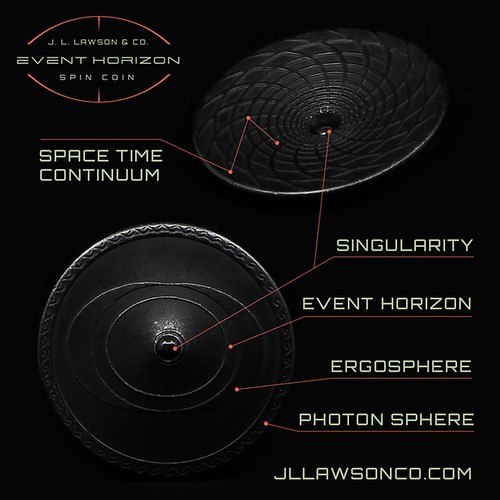
To read the complete article, see:
Event Horizon Spin Coin
(https://www.kickstarter.com/projects/jllawsonco/event-horizon-spin-coin)
RARE HBC PROMISSORY NOTE AT REGINA COIN SHOW

An extremely rare Hudson's Bay Company £1 1870 Promissory note issued at Fort Garry during the Red River Rebellion will be on display at the Regina Coin Club Show and Sale in October.
In 1869, the newly formed Government of Canada purchased Rupert's Land from the Hudson's Bay Company (HBC). In one small corner of the territory was the Red River Colony, situated where the Red and Assiniboine Rivers meet in what is now downtown Winnipeg. Most of the people in the Red River Colony were mixed race Metis, descendants of both French and English voyageurs, fur traders and farmers.
The first lieutenant governor, William McDougall, ordered surveyors to plot the land according to the square township system used in Ontario. Meanwhile, most of the Metis had previously made their farms on long, narrow lots fronting the rivers, and many did not have clear title to the land they farmed. By late 1869, Louis Riel emerged as the Metis leader and prevented the surveyors from entering the colony.
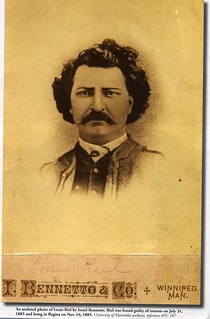 By late 1869, Louis Riel and his Metis supporters took over the fort at Fort Garry. In January 1870, Riel gained the support of most of the English-speakers in the colony, who agreed to form a Provisional Government to discuss terms to enter Confederation with Canada.
By late 1869, Louis Riel and his Metis supporters took over the fort at Fort Garry. In January 1870, Riel gained the support of most of the English-speakers in the colony, who agreed to form a Provisional Government to discuss terms to enter Confederation with Canada.
But not everyone in the settlement approved of the Metis demands. A small group of English-speaking Canadians in the area was opposed. These settlers organized a militia and some were captured and imprisoned at HBC trading fort a Fort Garry for attempting an insurrection against the Provisional Government.
Thomas Scott, an Orangeman, was sentenced to death by firing squad. Scott's death inflamed Ontario Protestants against the Metis, French-speakers and Catholics.
The Provisional Government then sent a delegation to Ottawa to negotiate. They were immediately imprisoned but soon released and entered negotiations with Prime Minister John A. Macdonald, who later agreed to enshrine many of the demands of the people of Red River Colony.
Manitoba, much smaller than it now is, became Canada's fifth province. Among the rights enshrined for the new province were a representative government, French language rights, separate Catholic schools and land rights for the Metis.
According to George B. Winship's manuscript, "Red River Disturbances," Louis Riel demanded that the HBC reopen their business so the colony and its Provisional Government could function properly as the rebellion and the closing of the HBC fort had drastically affected the fur trade and other trade as well. Riel guaranteed to protect the HBC in exchange for a loan of $25,000.
According to Winship, the HBC "tacitly complied with the demand, but in the matter of the loan they asserted that they did not have that amount of money on hand."
The problem was solved when it was suggested that HBC Promissory notes could be printed at the New Nation newspaper.
Winship, who printed the notes, recalled in his memoir: "Some heavy weight brown paper was procured, and the body of the note was set in long primer italic type… and the denomination of the bill in large type…. A certain number of sheets of paper were counted out for me to print and I was enjoined to account for all of them, spoiled and unspoiled. About $25,000 of these notes were printed and put in circulation after being signed by the Hudson Bay Co. officials."
After printing, the notes were signed by John Henry McTavish, the HBC clerk. They were then rubber stamped in red a few days later by William Mactavish, the Governor of Rupert's Land.
The £1 note on display is one of only a handful of Promissory notes still in existence. The notes were issued in four denominations: 5 shillings, one pound, 5 pounds and 10 pounds.
Canadian Prime Minister John A. Macdonald ordered troops under the command of Colonel Garnet Wolseley to take control of the new province. When the troops arrived at Fort Garry in August 1870, some of the Metis leaders, including Louis Riel, had left for exile in the U.S.
While in exile, Riel was elected to Parliament three times, but never took his seat as he feared he would be either imprisoned or hung for his role in the Red River Rebellion.
The Regina Coin Club show and sale takes place October 20-21, 2018 at the Turvey Centre near Regina.
For more information on the Regina Coin Club, see:
http://www.reginacoinclub.com/
DID RUSSIA WORLD CUP BANKNOTE PREDICT WIN?
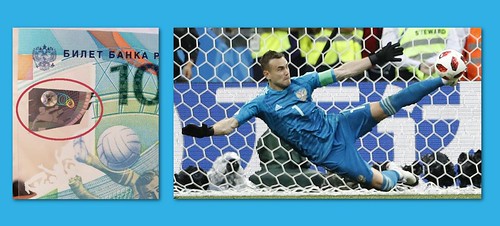
Few people could have predicted Russia's run from FIFA's 70th-ranked country to a spot in the 2018 World Cup quarterfinals. The Bank of Russia knew, however.
Kinda.
The Bank printed special 100 ruble notes in commemoration of the nation's hosting gig, a practice it had previously undertaken with special bills for the 2014 Winter Olympics and Russia's 2015 annexation of Crimea. The 2018 printing, however, seems to have predicted the future with its imagery.
Specifically one image of a diving player just barely getting his left foot on a ball. Turns out, that's exactly how Igor Akinfeev would save Iago Aspas's shootout penalty kick to give Russia one of the biggest upsets in World Cup history. Here's the note (check out the top left corner and not the guy, uh, totally botching a save).
To read the complete article, see:
Did Russia World Cup Banknote Predict Win?
(https://www.sbnation.com/2018/7/3/17532682/bank-of-russia-special-100-ruble-note-world-cup-save)
IN OTHER NEWS: JULY 8, 2018
1904 Olympic Gold Medal Brings $125,000
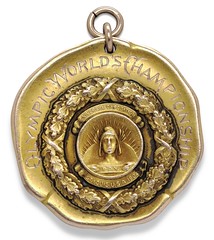
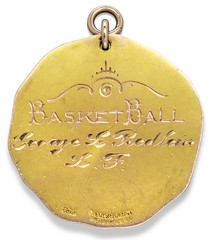
To read the complete lot description and price realized, see:
BASKETBALL – An Olympic Gold Medal awarded for Basketball to George Louis Redlein (1885-1968), St. Louis, 1904.
(https://www.christies.com/lotfinder/books-manuscripts/basketball-an-olympic-gold-medal-awarded-6145960-details.aspx)
To read the earlier E-Sylum article, see:
1904 OLYMPIC GOLD MEDAL FOR BASKETBALL
(http://www.coinbooks.org/v21/esylum_v21n20a32.html)
Will The New Academy Issue A Prize Medal?
The Swedish Academy is not awarding a Nobel prize for literature this year, but a group of Swedish cultural figures are coming together to bestow their own version of the world's most prestigious literary award instead, as an act of protest at the scandal that has engulfed the academy.
The scandal, which kickstarted debate about the academy's patriarchal nature and fights in the Swedish media between academicians, led to a wave of resignations and to the postponement of this year's prize "in view of the currently diminished academy and the reduced public confidence".
In its place, more than 100 Swedish writers, actors, journalists and other cultural figures have formed the New Academy, which will hand out its own award this autumn, following the same timeline as the Nobel.
To read the complete article, see:
Alternative Nobel literature prize planned in Sweden
(https://www.theguardian.com/books/2018/jul/02/alternative-nobel-literature-prize-planned-in-sweden)
Post Office Owes $3.55 Million Over Statue Mixup
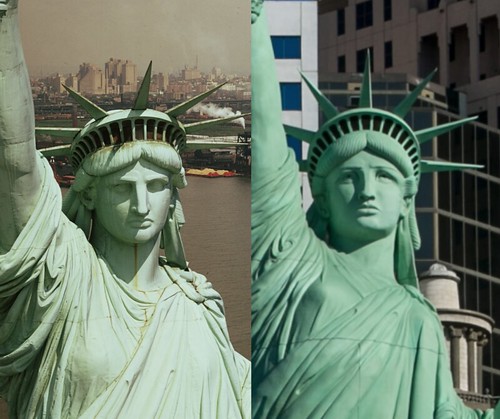
Left: Original Statue of Liberty
Right: Robert Davidson's Las Vegas replica
A sculptor who created a replica of the Statue of Liberty for a Las Vegas casino was awarded $3.5 million in damages last week after the US Postal Service (USPS) accidentally used a photo of his statue – rather than a photo of the original statue in New York harbor – on one of its most common stamps.
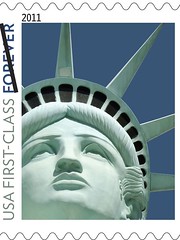 If you bought a "forever" stamp between 2011 and 2014, there's a good chance that it showed the face of the Statue of Liberty replica that sculptor Robert Davidson constructed for the New York-New York Hotel and Casino in Las Vegas. The Post Office licensed a photo of Davidson's statue from the image service Getty for $1,500, initially believing it was a photograph of the original statue. (The license only covered the rights to Getty's photograph of the statue – not the statue itself.)
If you bought a "forever" stamp between 2011 and 2014, there's a good chance that it showed the face of the Statue of Liberty replica that sculptor Robert Davidson constructed for the New York-New York Hotel and Casino in Las Vegas. The Post Office licensed a photo of Davidson's statue from the image service Getty for $1,500, initially believing it was a photograph of the original statue. (The license only covered the rights to Getty's photograph of the statue – not the statue itself.)
The stamp with the resulting image was released to the public in December 2010; it took four months before anyone pointed out the mistake to the Post Office.
To read the complete article, see:
Post Office owes $3.5M for using wrong Statue of Liberty on a stamp
(https://arstechnica.com/tech-policy/2018/07/post-office-owes-3-5m-for-using-wrong-statue-of-liberty-on-a-stamp/)
See also:
Postal Service misidentifies Statue of Liberty in stamp in a $3.5 million mistake
(https://www.usatoday.com/story/news/nation-now/2018/07/06/postal-service-misidentifies-statue-liberty-stamp-million-mistake/762306002/)
Harry Waterson writes:
I don't think the Post Office should have lost this case. That's just my opinion. It will be interesting to see if the Post Office appeals.
FIDEM Medals 2018
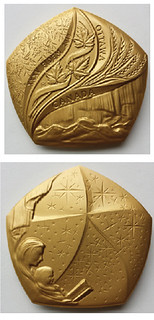 Every two years, the world's largest organization of medal artists and other aficionados of the medal comes together at the FIDEM congress. The acronym is a French one: "Federation Internationale de la Medaille," which is pretty easily translated to: International Federation of the Medal. Held at a different location each time, this year's federation or medals congress was in Ottawa, Ontario, hosted in large part by the Royal Canadian Mint and the Canadian Museum of Nature. It featured artists, scholars, collectors and others who are interested in any aspect of medal making and collecting.
Every two years, the world's largest organization of medal artists and other aficionados of the medal comes together at the FIDEM congress. The acronym is a French one: "Federation Internationale de la Medaille," which is pretty easily translated to: International Federation of the Medal. Held at a different location each time, this year's federation or medals congress was in Ottawa, Ontario, hosted in large part by the Royal Canadian Mint and the Canadian Museum of Nature. It featured artists, scholars, collectors and others who are interested in any aspect of medal making and collecting.
To read the complete article, see:
Medals of FIDEM: Breaths of fresh creative air
(http://www.numismaticnews.net/article/medals-of-fidem-breaths-of-fresh-creative-air)
VAULT RELEASE – RARE LINCOLN PENNIES!!!
Dear Expert,
Perhaps you can help me. I am interested in rare coins and the tremendous profits they offer. I recently saw this advertisement. Do you think I should mortgage my house and make aninvestment?
Wondering in Washington
Security Coin Advisory Marketing (SCAM) offers this limited opportunity.
Available only from us:
Vault Bags of Lincoln Pennies guaranteed to have either the Lincoln Memorial or a Shield on the reverse. We assure you that there are no wheat reverse coins; guaranteed. Every coin is certified as MS-71 by Certified Rarities Authentication Professionals (CRAP). This is a higher grade than any other rare company can offer! Other certification services offer no coins at all above MS-70.
Each coin is guaranteed to be made at the Philadelphia, Denver, or San Francisco Mint. We guarantee that there will be no West Point coins, doubled dies, or striking errors.
Each bag contains 1,000 pennies, as counted by our row of uniformed guards on our production line (with security vaults in the background). Wait! There's more! As a bonus every bag will also include five (5) Jefferson nickels guaranteed to have been minted since 1937!
Your cost is just $49.95 per bag! (Plus just $10 shipping) Strict limit of 10 bags per buyer per day; offer expires December 31, 2019. Each bag comes with a numbered certificate of authenticity.
This offer is limited only to buyers who can qualify on these points:
1. You must have a zip code starting with a number from 0 to 9. Anyone without a zip code cannot place an order. This is a very strict rule; sorry, no exceptions.
2. Our toll-free operators are available only from 12:01 a.m. until 11:55 p.m. each day, except April 1. Positively no orders can be placed from 11:55 p.m. to 12 midnight, or on April 1.
3. Payment must be made in cash or by credit card. In addition, American Gold Eagles are accepted at the spot price for bullion, less 10% service and handling.
Disclaimer: SCAM is an independent company. We are not affiliated with the government or any numismatic association. Thus, we can give more liberal investments than would be possible under regulation. With us the sky's the limit! We do not reveal our clients' names to any agency or authority. Only you will know of your private reserve!
The prices of collectible coins can vary depending upon the economic climate, the weather, the strength of the aftermarket (if there is one), and other factors. Accordingly, neither SCAM nor any other company can guarantee profits. We do mention that there are some pennies such at 1793 that sell for thousands of dollars.
FEATURED WEB SITE: SHORT SNORTER PROJECT
This week's Featured Web Site is the Short Snorter Progect, suggested by John and Nancy Wilson, who write:While researching our USA * USN 1 Atomic Short Snorter - Bikini JTF-ONE CROSSROADS with a ship depicted on the back we found a site that archives Short Snorter's. We think you will be impressed with this site and don't recall it being listed before.
A short snorter is a banknote which was signed by various persons traveling together or meeting up at different events and records who was met. The tradition was started by bush pilots in Alaska in the 1920's and subsequently spread through the growth of military and commercial aviation. If you signed a short snorter and that person could not produce it upon request, they owed you a dollar or a drink (a "short snort", aviation and alcohol do not mix!)
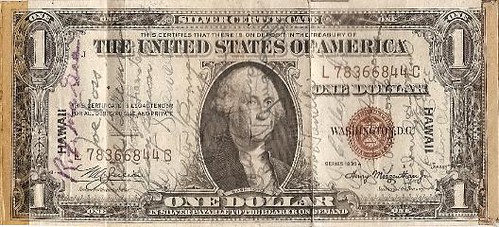
Short snorter signed by WWII Marine Corps fighter ace and Congressional Medal of Honor recipient Joe Foss
http://www.shortsnorter.org/

